Whilst my passion for railways has its roots in childhood spotting days during the Fifties, by the early Sixties the hobby was running out of steam. It began in 1955 when the British Transport Commission  (BTC) announced the Modernisation Programme which outlined the BTC's plan to replace old-fashioned steam power with modern diesel and electric traction.
(BTC) announced the Modernisation Programme which outlined the BTC's plan to replace old-fashioned steam power with modern diesel and electric traction.
The turning point came when my tatty old Ian Allan abc needed replacing and I splashed out the princely sum of 10/6d on the latest Winter 1958-59 combined edition. How many remember the book's heady aroma of freshly printed ink? Ian Allan should've bottled it; they'd have made a fortune!
Next a start was made on the depressingly predictable task of transferring the logged numbers from my old abc, but by the time I reached the BR Standard classes Nos 70000-92250, I had lost count of the number of gaps due to scrapping.  Worse still, when it came to underlining the new diesels I had 'copped' on visits to Swindon, Derby and Crewe Works, they didn't enter the equation because Ian Allan had published the new combined edition before the diesels were built.
Worse still, when it came to underlining the new diesels I had 'copped' on visits to Swindon, Derby and Crewe Works, they didn't enter the equation because Ian Allan had published the new combined edition before the diesels were built.
Call it a dereliction of duty, if you like, but the discrepancies creeping into the hobby were totally at odds with the orderliness that spotters expected, and I ended up joining the legion of disenchanted youngsters who turned their attention to something more rewarding like railway photography - a natural adjunct to train spotting.
So, combining both interests from old spotting days, the purpose of this page is to list as many different steam locomotive classes (numbered from 40000 to 5999) which were listed in Ian Allan's abc Locospotters Book covering the London Midland Region in 1959. 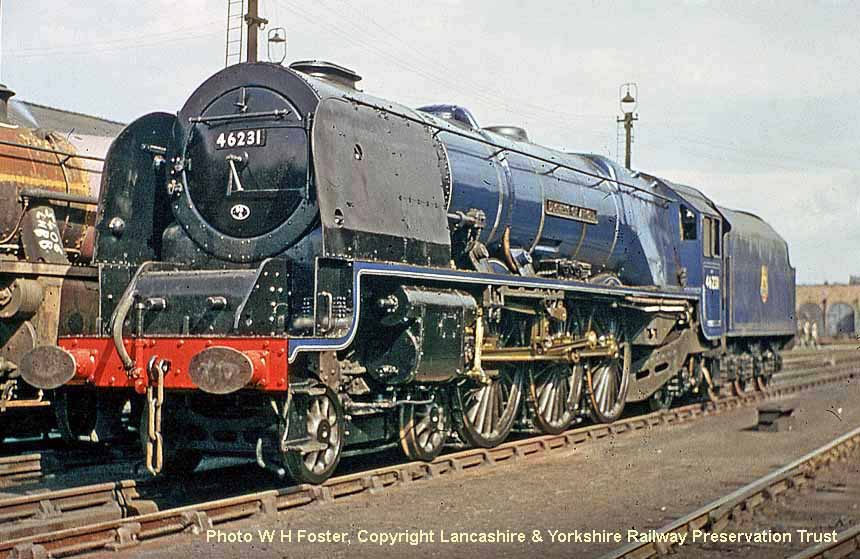
(Above) We start with a lovely colour shot of a Class 8P Pacific 46231 Duchess of Atholl at Crewe Works. After nationalisation in 1948, the newly-formed British Railways tried out a number of liveries with a view to adopting a future standard for its express-passenger engines of Class 8 power classification (dark blue) and for its fleet of express-passenger locomotives with a lower tractive effort (light green). Eventually a lighter shade of blue was chosen for its large express locos, which included the Peppercorn and Gresley Pacifics of the Eastern and North Eastern Regions, the ex-SR 'Merchant Navy' Pacifics of the Southern Region, the ex-GWR 'King' class 4-6-0s for the Western Region and Stanier's ex-LMSR Pacifics. This fine shot of a blue-liveried 46231 Duchess of Athol outside the Paint Shop at Crewe Works was taken by W H Foster, who donated the slide to the Lancashire & Yorkshire Railway Preservation Trust for money raising purposes.  Established in 1988, the origins of the Lancashire & Yorkshire Railway Trust can be traced back to the Lancashire & Yorkshire Railway Preservation Society when a group of Rochdale railway enthusiasts led by Richard S Greenwood, formed the L&Y Saddletank Fund and acquired 3 locomotives, a carriage and 3 wagons. In 1987 the 'Fund' changed its identity to the Lancashire & Yorkshire Railway Preservation Society and started negotiations to form a Charity to secure the collection, thus ensuring that the influence of the Lancashire & Yorkshire Railway continues to the present day. If you are interested in helping with the Trust's praiseworthy effort to restore and conserve the quality of L&Y workmanship, click HERE to visit the Trust's website to find out more; indeed you can make a big difference by providing either your skills in engineering or carpentry, or perhaps you are simply competent at DIY...you will be welcome with open arms!
Established in 1988, the origins of the Lancashire & Yorkshire Railway Trust can be traced back to the Lancashire & Yorkshire Railway Preservation Society when a group of Rochdale railway enthusiasts led by Richard S Greenwood, formed the L&Y Saddletank Fund and acquired 3 locomotives, a carriage and 3 wagons. In 1987 the 'Fund' changed its identity to the Lancashire & Yorkshire Railway Preservation Society and started negotiations to form a Charity to secure the collection, thus ensuring that the influence of the Lancashire & Yorkshire Railway continues to the present day. If you are interested in helping with the Trust's praiseworthy effort to restore and conserve the quality of L&Y workmanship, click HERE to visit the Trust's website to find out more; indeed you can make a big difference by providing either your skills in engineering or carpentry, or perhaps you are simply competent at DIY...you will be welcome with open arms!
(Below) This dinky-sized 'old timer' is one of Aspinall's 0-4-0 saddle tank designs, introduced in 1891 for the Lancashire & Yorkshire Railway and designated Class 21. Note the wooden blocks on the buffer beam which were ideal for dock shunting purposes. The last LYR Pug in BR service was a Western Region loco. However, this privately preserved Pug 51218 (acquired by the L&Y Saddletank Fund) was photographed by Richard Greenwood at Newton Heath shed on a very gloomy 18 February 1967 as it was being prepared to work three brakevan trips between Rochdale and Whitworth the following day. No 51218 has the distinction of being the first preserved loco to arrive on theKeighley & Worth Valley Railway on 1st July 1965.
LONDON MIDLAND REGION LOCOMOTIVES 40000-41199.
40001-40070. (Above-Insert-Below) Introduced in 1930, Sir Henry Fowler's LMS Class 3P 2-6-2Ts numbered 40001 to 40070 in the BR fleet was the first of the engines listed on the London Midland Region. A total of  70 were built for use primarily on local passenger services, four on the Western Region, the rest on the London Midland Region. (Above) The class was most easily identifiable from other 2-6-2Ts by their parallel boiler and smokebox curving down to meet the frames, which can be seen in this ER Morten shot of No 40058 entering Shrewsbury station with a local passenger train. (Below) Sporting a St Albans (14C) shedplate on the smokebox door No 40024 - one of twenty Fowler Class 3MT tanks (Nos 40021-40040) fitted with condensing apparatus for working the Metropolitan widened lines through the tunnels to Moorgate Street - is seen heading a suburban service at Aldersgate & Barbican(Inset) The 'Delph Donkey' being propelled by push-pull fitted Fowler Class 3MT 2-6-2T No 40012. Visible in the background is Saddleworth station (closed 5th October 1968).
70 were built for use primarily on local passenger services, four on the Western Region, the rest on the London Midland Region. (Above) The class was most easily identifiable from other 2-6-2Ts by their parallel boiler and smokebox curving down to meet the frames, which can be seen in this ER Morten shot of No 40058 entering Shrewsbury station with a local passenger train. (Below) Sporting a St Albans (14C) shedplate on the smokebox door No 40024 - one of twenty Fowler Class 3MT tanks (Nos 40021-40040) fitted with condensing apparatus for working the Metropolitan widened lines through the tunnels to Moorgate Street - is seen heading a suburban service at Aldersgate & Barbican(Inset) The 'Delph Donkey' being propelled by push-pull fitted Fowler Class 3MT 2-6-2T No 40012. Visible in the background is Saddleworth station (closed 5th October 1968). 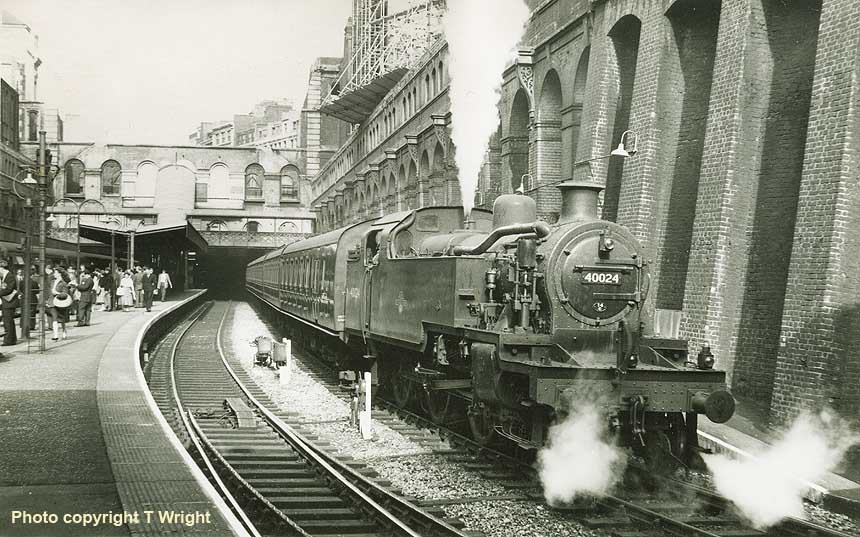
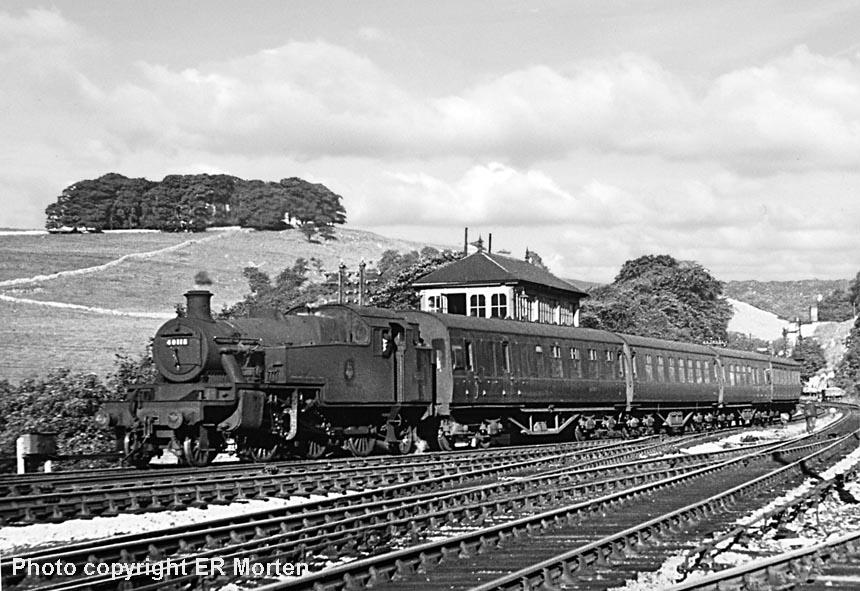
40071-40209 (Above-Below) Introduced in February 1935, the Stanier 3MT 2-6-2T was a development of the earlier 1930's Fowler 2-6-2T mentioned above. Both classes were identical in many respects; the Stanier engines had the same 5ft 3in driving wheels, 3ft 3½ins pony wheels and trailing wheels, identical sized cylinders at 17½in X 26ins, the same 21,485lb tractive effort, 200 lb.sq.in. boiler pressure, 3 ton coal capacity, 1,500 gallons of water and 41ft 11¾ins length over buffers. However, a distinguishing feature of the Stanier design was the pronounced slope to the top of their side-tanks and tapered boiler in contrast to the parallel boiler of the Fowler 2-6-2Ts. (Above) No 40018 departs from Millersdale on the push-pull shuttle service to Buxton on 16th August 1950. (Below) Rebuilt in 1941 with larger boiler, No 40148 heads a Bradford-Forster Square- Leeds City express past the site of the proposed new Apperley Bridge station on 19th April 1952.

40332-40557 (Above) Former Midland Railway Class 2 (LMS Class 2P) No 40491 (built in October 1896) awaits departure from Sheffield Midland with a local train on 24th April 1952. Originally constructed by SW Johnson, the MR's CME 1873-1903, this 4-4-0 class was rebuilt by his successor RM Deeley (MR's CME 1903-1909) with superheater and piston valves. No 40491 was among only a few survivors of this once extensive class totalling 245 - only thirty six engines were still listed in my 1958-59 winter abc; No 40491 was withdrawn in October 1960. The majority of the 2Ps were allocated to sheds on the old MR system, chiefly in the Midlands.
40563-40700 (Below) Introduced in 1928 these 4-4-0s were the result of Sir Henry Fowler's post-grouping development of the earlier MR Class 2P with modified dimensions (smaller 6ft 9in driving wheels) and reduced boiler mountings. Out of the original 138 members built, no fewer than 134 were still listed in my abc, but only just...with the onset of dieselisation they were diminishing fast and all had gone by the end of 1962. The class was adopted by the LMS as a standard light passenger engine and many went to Scotland for service on the Glasgow and South West routes. During BR days the Class 2P continued to operate on the Scottish Region, principally around Kilmarnock. Some tenty years after its introduction in September 1931, No 40647 heads a local train at Ayr on 27th July 1951. The loco was withdrawn in October 1961. Note the Fowler flat sided tender which differed from the earlier Midland tender with coal rails as seen attached to 40491 above.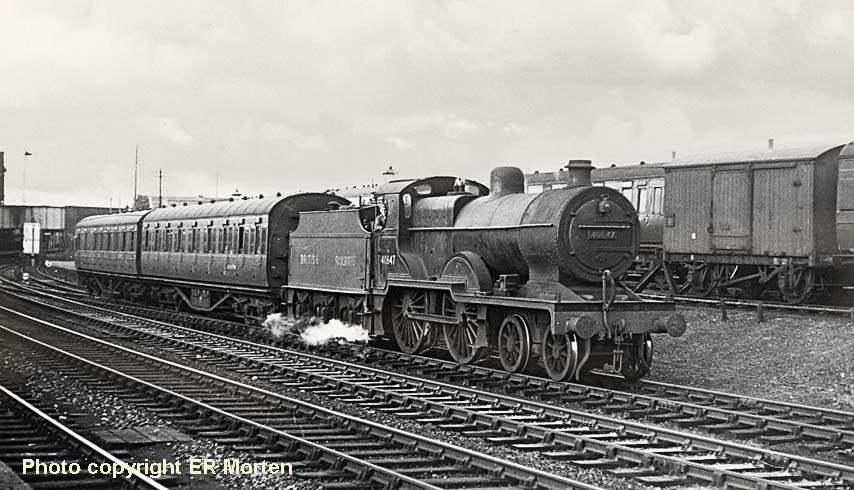

40907-41193 (Above-Inset-Below) Listed among the engines in my Ian Allan abc Locospotters Book (1958-59 winter edition) are 33 'Compound' Class 4P 4-4-0s Nos 40907-41193, albeit the sequence of numbers reveal ominous gaps due to scrapping. By the summer of 1960 only four remained in BR stock: No 40907 at Millhouses (Sheffield), 41063 at Manningham (Bradford) and the remaining two at Monument Lane (Birmingham). (Above) This once popular and highly efficient class produced some splendid performances during the earlier years of grouping on the Birmingham two-hour expresses from Euston, and also duties  in Scotland on the former Caledonian Railway and G&SWR main lines. (Inset) The class was developed from the original five 7ft 'Compound' 4-4-0s introduced in 1902 by Samuel W. Johnson, CME of the Midland Railway 1873-1903 based at Derby. The 3-cylinder compound arrangement comprised one high pressure cylinder inside the frames, and two low pressure cylinders outside. From 1905 onwards, Johnson's successor at Derby, Richard M Deeley, built a simpler version based on Johnson's original 4-4-0 design which made the engines more straightforward to drive. The Johnson locomotives were subsequently rebuilt as Deeley Compounds and outshopped with smaller 6ft 9in couple wheels and superheater, including the now-preserved 1000 in 1914. The doyen of the class was destined for preservation after withdrawal in 1959 and restored in Midland maroon livery for display at Clapham Transport Museum. Here No 1000 was photographed by Frank Ashley heading the return leg of an SLS railtour from York to Birmingham New Street via Doncaster, Sheffield and Derby at Ambergate on 31 August 1959. (Below) The Compound Class 4P 4-4-0s were numbered 40900-40939 and 41045-41199 in the BR fleet, but it should be noted that Nos 40940-40999 were not built. However, with the onset of dieselisation and the introduction of more modern BR Standard steam classes they were early candidates for withdrawal. Here, No 40937 is seen on its home shed at Bank Hall (27A)...TO BE CONTINUED.
in Scotland on the former Caledonian Railway and G&SWR main lines. (Inset) The class was developed from the original five 7ft 'Compound' 4-4-0s introduced in 1902 by Samuel W. Johnson, CME of the Midland Railway 1873-1903 based at Derby. The 3-cylinder compound arrangement comprised one high pressure cylinder inside the frames, and two low pressure cylinders outside. From 1905 onwards, Johnson's successor at Derby, Richard M Deeley, built a simpler version based on Johnson's original 4-4-0 design which made the engines more straightforward to drive. The Johnson locomotives were subsequently rebuilt as Deeley Compounds and outshopped with smaller 6ft 9in couple wheels and superheater, including the now-preserved 1000 in 1914. The doyen of the class was destined for preservation after withdrawal in 1959 and restored in Midland maroon livery for display at Clapham Transport Museum. Here No 1000 was photographed by Frank Ashley heading the return leg of an SLS railtour from York to Birmingham New Street via Doncaster, Sheffield and Derby at Ambergate on 31 August 1959. (Below) The Compound Class 4P 4-4-0s were numbered 40900-40939 and 41045-41199 in the BR fleet, but it should be noted that Nos 40940-40999 were not built. However, with the onset of dieselisation and the introduction of more modern BR Standard steam classes they were early candidates for withdrawal. Here, No 40937 is seen on its home shed at Bank Hall (27A)...TO BE CONTINUED.
We continue the page with a visit to Willesden Motive Power Depot in London, courtesy of two fine railway photographers, Alex (Mac) McClymont and Keith Long, both ex-railwaymen....
WILLESDEN MOTIVE POWER DEPOT 1A
(Below) Willesden depot was classified as 1A, this being the first of the alpha-numerical shed coding system, which, for this young spotter back in the Fifties, somehow bestowed a level of prestige over the remaining BR sheds listed beneath it. This system had its origins back in the Thirties when the LMS carried out a reorganisation of locomotive operation and maintenance, and henceforth all sheds were grouped into districts with the main depot being allocated the code letter A, followed by a number of subsidiary sheds listed in alphabetical order. An extension of this system was adopted by BR in 1950 before it was replaced by an alphabetic code for BR's diesel fleet in 1973. (Below) A famous LMS Poster 'The Day Begins - 1946' by Terence Cuneo, measuring 50" x 40", shows a wonderful image of Princess Coronation Class locomotive City Of Hereford being prepared on the turntable at Willesden shed. This vibrant poster went under the hammer for a whopping £6,100 at a Creat Western Railwayana Auction in November 2012...click HERE. 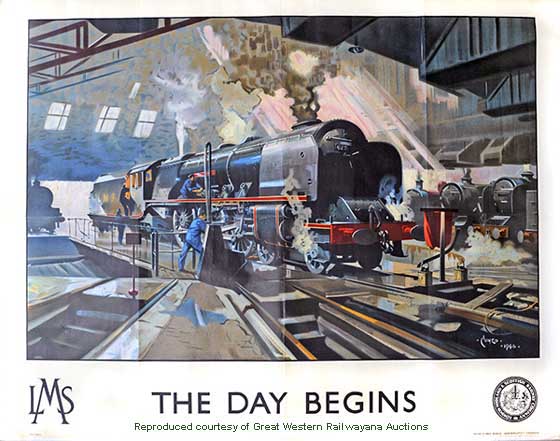

(Above-Below) Ex-SR engineman Alex (Mac) McClymont is a major contributor to this site. He has a Rail Cameraman page featuring Eastern Region steam days at Kings Cross and a gallery of Southern Region photos on Geoff Burch's 'SR Enginemen Remember' pages. In this shot an assortment of locomotives are lined up in front of the 12-road running shed at Willesden depot on 16th June 1962. A little over three years later the shed was closed on September 27th 1965 and the site cleared to make way for a Freightliner depot. (Below) Stanier Black Five 44916 based at Willesden (1A) prepares to move off shed on 16th June 1962. Built at Crew in 1945, she ended up at Stockport Edgeley and was withdrawn in December 1967.

(Above-Below) Stanier Black Five 45111 was photographed at Willesden on 16th June 1962. Built in 1935 at the Vulcan Foundry works and a Willesden based locomotive (1A) at the time she was photographed, she ended her life at Rose Grove (24B) and withdrawn in October 1967. (Below) Stanier 8F Class 48668 was built at Brighton works and her last shed was Leicester (15C).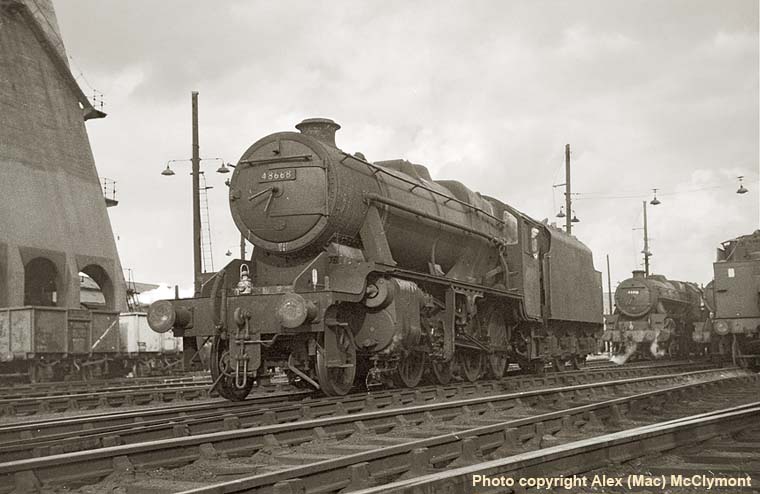

(Above-Below) Stanier 'Jubilee' Class 45669 'Fisher' in Willesden Shed on 16th June 1962. On 29 April 1935 No 5552, the first of the class, permanently swapped identities with 5642 which had been named 'Silver Jubilee' on 19th April 1935 in recognition of the Silver Jubilee of King George V on 6th May of that year. This change gave the name to the rest of the class. (Below) A general view of of locos stabled around the turntable.

(Above-Below) Another major contributor to this site is retired railway signalman, Keith Long, who has his own Rail Cameraman page. Keith goes by the name of 'Cabsaab 900' on his superb 'Flickr photostream. Here he captures the light and shade inside the steam roundhouse at Willesden 1A on a bright summer's day on July 2nd 1961. This shows the the second of HG Ivatt's pioneering Co-Cos No 10001 and BR's Type  2 Bo-Bo No D5031 tucked away in the stalls around the turntable. No 10001 was built at Derby Works and delivered to 1B Camden on 10th July 1948; withdrawal came on 12th March 1966 after 1,101,700 miles in service and she was scrapped at Cox & Danks of Acton in February 1968. By comparison No D5031 is a jumped-up whippersnapper!....built at BR Crewe Works and delivered new to 31B March on 25th June 1959, the loco became TOPS Class 24 No 24031. Withdrawn in October 1975 she was scrapped at Swindon Works in December 1976. Keth comments on his 'Cabsaab900' Flickr Photostream - 'At the time this photo was taken No 10001 was just a week short of her 13th birthday (almost a teenager) and D5031 is a week past her second (barely out of nappies) and there isn't a yellow warning panel to be seen anywhere!' (Below) Another classic photo of the transition from steam at Willesden. These shots were taken on Keith's trusty Ensign Selfix 820 and shows Type 2 Bo-Bo No D5089 and the second of the SR's Ashford Works 1Co-Co1's No 10201 inside the steam roundhouse on 16th September 1961.
2 Bo-Bo No D5031 tucked away in the stalls around the turntable. No 10001 was built at Derby Works and delivered to 1B Camden on 10th July 1948; withdrawal came on 12th March 1966 after 1,101,700 miles in service and she was scrapped at Cox & Danks of Acton in February 1968. By comparison No D5031 is a jumped-up whippersnapper!....built at BR Crewe Works and delivered new to 31B March on 25th June 1959, the loco became TOPS Class 24 No 24031. Withdrawn in October 1975 she was scrapped at Swindon Works in December 1976. Keth comments on his 'Cabsaab900' Flickr Photostream - 'At the time this photo was taken No 10001 was just a week short of her 13th birthday (almost a teenager) and D5031 is a week past her second (barely out of nappies) and there isn't a yellow warning panel to be seen anywhere!' (Below) Another classic photo of the transition from steam at Willesden. These shots were taken on Keith's trusty Ensign Selfix 820 and shows Type 2 Bo-Bo No D5089 and the second of the SR's Ashford Works 1Co-Co1's No 10201 inside the steam roundhouse on 16th September 1961. 

(Above-Below) In pre-digital days - before cameras were equipped with auto-focussing and through the lens light metering - few photographers attempted interior shots of steam sheds; they were dark and dismal places where the changing light made it difficult to get the exposure right. Nonetheless, the results could be most rewarding, and Keith managed to produce a few 'gems' for his collection, including this one of 'Patriot' class No 45546 Fleetwood, still fitted with the original Belpaire boiler and single chimney, at Willesden shed (1A). (Below) One of the great things about opening a Flickr account is that visitors to your site get the chance to comment on your photos. For example, this excellent interior shot at Willesden depot of HG Ivatt's Co-Co No 10000 on 2nd July 1961 created some dialogue. It goes to prove that there must be countless thousands of enthusiasts who were disappointed that such an important locomotive was not saved from the cutters torch, including Keith who has posted his own comments - 'The real shame is that the loco survived so long after being withdrawn in December 1963 (it was not cut up until January 1968). It would have been better to have saved something like this rather than say eleven out of the thirty 'Merchant Navy' class. It's not that I have anything against the MNs, or steam in general; it's just that the preservation scene is so unbalanced.' Click this link to visit Keith's main collection; it contains a massive number of sets of BR steam-diesel days.
A RAILWAYMAN'S MEMORIES
Tony Thompson, ex-Agecroft, Patricroft and Crewe, remembers a fateful trip on the 11.20pm Manchester to Glasgow in the summer of 1961…
During my firing days at Patricroft shed, the so-called 'No 4 goods link' job had more top passenger work than goods work. One evening during the summer of 1961 I had booked on duty at 9.35pm for the 11.20 Glasgow, which we called the '11.20 papers'; it also included two Royal Mail vans with mail catchers on opposite sides for the return journey. My driver that night was Maz, and as we prepared the Jubilee, I oiled  the big and small ends for him (I always had a spare pair of overalls in my locker for 3 cylinder engines) and filled the firebox slowly during preparation. Then before we left the shed we topped up the tender and trimmed the coal for safety, which is more than can be said for the Newton Heath men that hooked onto us at Manchester Victoria…but I'll come to that later.
the big and small ends for him (I always had a spare pair of overalls in my locker for 3 cylinder engines) and filled the firebox slowly during preparation. Then before we left the shed we topped up the tender and trimmed the coal for safety, which is more than can be said for the Newton Heath men that hooked onto us at Manchester Victoria…but I'll come to that later.
At 10.40pm we left Patricroft shed light engine for Manchester Victoria's platform 11, which more or less encroached on Exchange's platform 3. We hooked on to the train at 10.55pm and some 5 minutes later the Newton Heath men hooked on the front of us with one of the low-framed Caprotti black 5s.
The reason for double heading this turn was to tackle Pendlebury Bank, especially with 16 bogies on; it was a very heavy train filled mostly with mail and papers plus parcels. The timings to Preston was 43 minutes, but as usual our departure was held up by the paper guys, never the Post Office, and this delay could be anything up to eight minutes before we got away.
A few minutes before our scheduled departure I put a few rounds on; I had a good box with fullback damper open and near to blowing off, but one always has the gauge glass at approx ¾ or less to keep her quiet. The advantage of this job was that after starting from platform 11 we passed through platform 3, then across a series of crossings to get onto the Lanky, the fireman could drop the steam pressure to just above 200lbs then have his pressure up to 225lbs psi before Salford Station.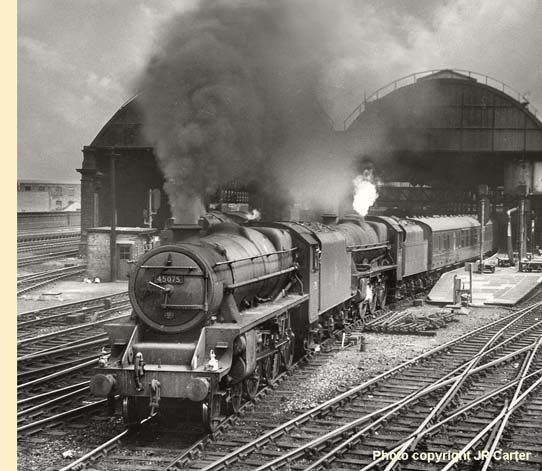 Having got the right of way at 11.27pm, Maz opened the regulator and we stormed through Exchange then with the second valve and reverser pulled right back, we headed across onto the Lanky. From then on it was all systems go and both engines were soon pounding through Salford Station, the 5x roaring and the black 5 blasting. Approaching Pendlebury Bank we had a full 7 minutes to make up, so it was shovel in hand and a few rounds for the climb ahead, but the 5x was in fine fettle so keeping her around the 225 mark was comfortably easy.
Having got the right of way at 11.27pm, Maz opened the regulator and we stormed through Exchange then with the second valve and reverser pulled right back, we headed across onto the Lanky. From then on it was all systems go and both engines were soon pounding through Salford Station, the 5x roaring and the black 5 blasting. Approaching Pendlebury Bank we had a full 7 minutes to make up, so it was shovel in hand and a few rounds for the climb ahead, but the 5x was in fine fettle so keeping her around the 225 mark was comfortably easy.
As we neared the top of the bank I shoveled a few more rounds into the firebox before we leveled out in anticipation of Walkden Water Troughs, serving all four tracks - 'Fast' and 'Slow' Lines. Ahead we had 14 miles of near straight level track and both engines were flat out, doing over 75mph on the approach to the troughs.
At this juncture, it should be explained that the practice for picking up water with a double-headed train was that the leading engine dipped first and as the spray started to dwindle the train engine dipped second. However, this particular night things didn't go quite as smoothly! When the time came for both firemen to prepare for the water troughs, I got off my seat and walked towards the water scoop handle when I heard an almighty crash behind me! Spinning round I saw a large chunk of coal had smashed through my window and shattered in the cab!
So much for trimming the tender on the part of the 26A men! I dread to think what might have happened to me had it been three seconds earlier! With hindsight, l can only assume the bridge we'd just passed under was lower than the previous bridges, and as a result the coal had been dislodged from the tender of the leading engine, came hurtling along the top of our boiler barrel and smashed through my glass! Make no mistake I was shaken up but somehow managed to drop the scoop and top up the tender. After removing the broken glass from the window, I could put my head out of my side window at speed, but sitting on my seat in front of the missing glass took my breath away, so I ended up standing between firing, putting the injector on and keeping the footplate clean and dampened down. By the time we got to Peel Hall Sidings we were doing 86/88mph on the approach to Hilton House Junction and took the extreme right hand peg over the Whelley to join the West Coast Main Line. My driver Maz blew the whistle to get the attention of the leading engine crew and alert the bobby to wire Preston for a fitter to fix a new glass to the fireman's side.
With hindsight, l can only assume the bridge we'd just passed under was lower than the previous bridges, and as a result the coal had been dislodged from the tender of the leading engine, came hurtling along the top of our boiler barrel and smashed through my glass! Make no mistake I was shaken up but somehow managed to drop the scoop and top up the tender. After removing the broken glass from the window, I could put my head out of my side window at speed, but sitting on my seat in front of the missing glass took my breath away, so I ended up standing between firing, putting the injector on and keeping the footplate clean and dampened down. By the time we got to Peel Hall Sidings we were doing 86/88mph on the approach to Hilton House Junction and took the extreme right hand peg over the Whelley to join the West Coast Main Line. My driver Maz blew the whistle to get the attention of the leading engine crew and alert the bobby to wire Preston for a fitter to fix a new glass to the fireman's side.
By now we had recovered some time; we passed the 20mph restriction at Hilton House box, but once we were on the West Coast mainline down fast, it was back to sparks flying from both engines, especially the 5x - and, of course, the shovel was being used fast and furious to get us into Preston. We had a very fast run down to Preston, lurching over Euxton Junction at nearly 90! After such an unusual trip we arrived 1  minute late, but saw no sign of a fitter, the Newton Heath men hooked off and went on their merry way (the 26A men were booked to work a train back from Preston, and we at 26F had a Fish train from Law Junction to Oldham Road). When the Preston men relieved us to take the '11.20 papers' north I put my express lamps on and I explained to the driver and fireman what had happened.
minute late, but saw no sign of a fitter, the Newton Heath men hooked off and went on their merry way (the 26A men were booked to work a train back from Preston, and we at 26F had a Fish train from Law Junction to Oldham Road). When the Preston men relieved us to take the '11.20 papers' north I put my express lamps on and I explained to the driver and fireman what had happened.
Our return trip to Manchester was delayed - the fully-fitted Fish train arrived at Preston more than an hour behind schedule at 2.15am, but as the train rolled into the platform I couldn't have wished for a more welcoming sight - it was my favourite 'Jubilee' class 5596 Bahamas and looking in super condition. When we arrived at Manchester we headed up Platting Bank, then at Miles Platting Station propelled our train back down the bank into Oldham Road Goods Yard, hooked off and headed light engine to Patricroft Shed…the end of a good nights work, signed off, and home James...
THE DAVE SALMON COLLECTION
Captions by Derek Dean
Former Guildford railwayman, Dave Salmon, a true character and best known by work colleagues and close friends for his unadulterated passion for railways, aircraft, buses, sport and his love of photography, sadly passed away aged 78 in July 2015. Dave bequeathed his photographic archive to fellow railwayman, Geoff Burch - see pages 32-37 - who has generously allowed reproduction of a selection of photographs taken on Saturday 8th July 1967 during Dave's visit to Motive Power Depots in Lancashire before their closure, followed by a Carlisle Rail Tour on 22nd January 1968 in the final year of BR steam.
I am also extremely grateful to Derek Dean - see pages 90-92 - who has pulled out all the stops in creating the evocative captions…a fitting tribute to steam's final years.
(Above-Inset) From the longest railway platform in Europe, Dave Salmon captures a quiet moment with a restrained unassuming calmness, a short-lived break from the usual humdrum of a very busy main line station. However if we were able to close our eyes and concentrate for just a moment, we could be seated in the local symphony hall listening to music from composer Ralph Vaughan Williams; the gentle hiss of steam mimicking the soft sounds of orchestral strings, the distant movement of passengers akin to piano play, the 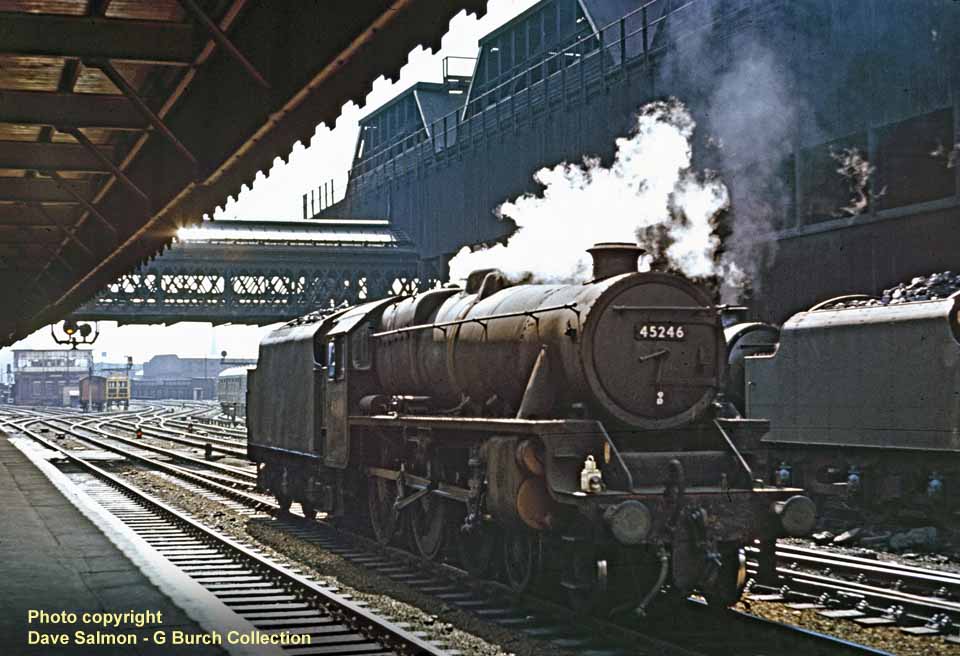 circulatory movement of water in the boiler echoing cello, with the distant rhythms of a hard-working loco reflecting the kettle drums. But our vivid imagination is brought to an abrupt halt via a loud shrill whistle calling for attention as an approaching train enters the vast auditorium of Manchester Victoria Station. The two Stanier Class 5 engines stand as if on a stage before a large audience, the quiet before the storm, the lull before the crescendo when the engines move forward to bank a train up Miles Platting Bank, a mile-long incline that varied between 1 in 47 and 1 in 59, a decidedly hard task for a loaded express setting out from Manchester Exchange station. Meanwhile these two engines survived another near 12 months of service, though regular passenger work was not forthcoming as steam's decline continued without abatement. It is very useful to have two very similar engines for comparison, as here, for we can observe that the top-feed on No 44683 is further forward to that of No 44949; also the chimneys are of different heights, as are the domes over their relative boilers.
circulatory movement of water in the boiler echoing cello, with the distant rhythms of a hard-working loco reflecting the kettle drums. But our vivid imagination is brought to an abrupt halt via a loud shrill whistle calling for attention as an approaching train enters the vast auditorium of Manchester Victoria Station. The two Stanier Class 5 engines stand as if on a stage before a large audience, the quiet before the storm, the lull before the crescendo when the engines move forward to bank a train up Miles Platting Bank, a mile-long incline that varied between 1 in 47 and 1 in 59, a decidedly hard task for a loaded express setting out from Manchester Exchange station. Meanwhile these two engines survived another near 12 months of service, though regular passenger work was not forthcoming as steam's decline continued without abatement. It is very useful to have two very similar engines for comparison, as here, for we can observe that the top-feed on No 44683 is further forward to that of No 44949; also the chimneys are of different heights, as are the domes over their relative boilers. 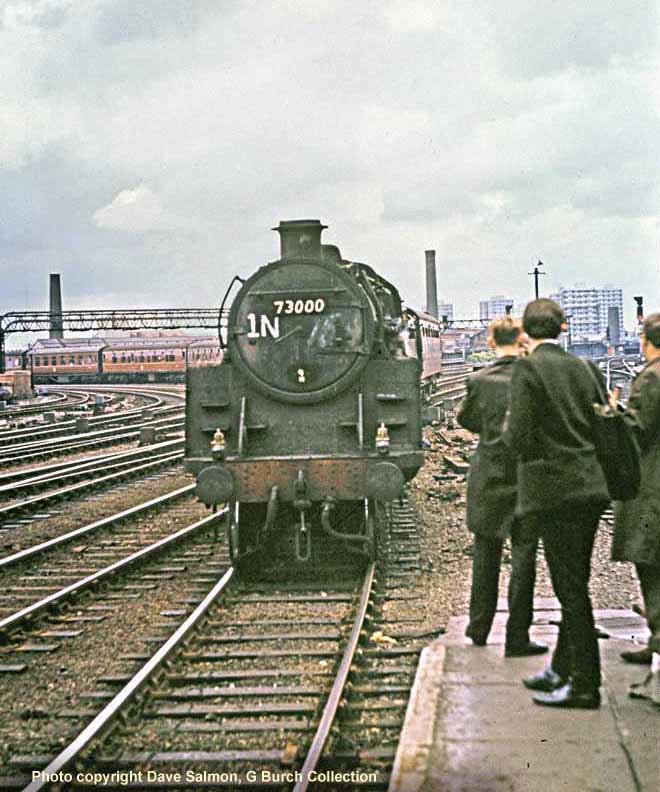
(Above) A group of enthusiasts gather at the platform end to record the scene of Class leader BR Standard 4-6-0 No 73000 entering Manchester Victoria Station. No anoraks in view here, no scruffy oiks with their fish paste sandwiches to lessen the tone, only smartly turned out young lads off to do some serious shed 'bashing' as the realisation has dawned that the end of steam was now a racing certainty. No more saving your pocket monies to buy the latest ABC volume; no more bike rides to the local shed to seek out the denizens therein on the lookout for any 'foreigners' that may have come from faraway yards, eager to please grateful eyes.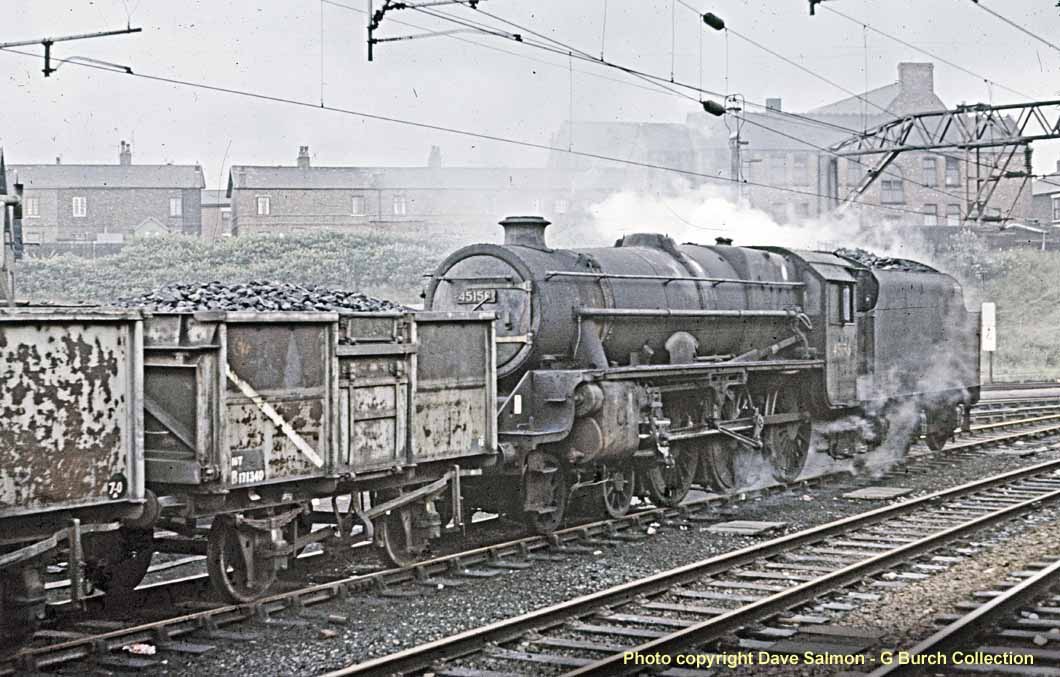
(Above-Below) The Stanier-designed engines gave rise to 1,033 locomotives of 4-6-0 configuration, of which by and large the renowned 'Black Five' was the most universally accepted by crews and running sheds. Even more desirable for spotters were the four 5MTs allocated to St Rollox (65B) in Scotland, all furnished with official names of Scottish Regiments. What is little known, however, is there were in fact five 5MTs sporting titles, as No 45155 also carried the nameplate The Queens Edinburgh from 1942 to 1944, all five bearing monikers of Regiments concerned. However the scene captured here by Dave Salmon is a far cry from its days hauling 'The Saint Mungo' express service from Glasgow to Aberdeen, a duty for which the shed staff would clean the engine regularly in order to display a good impression to the general public. Obviously no such exertions have been bothered with here, now typically bereft of dignity and devoid of any colour, unless you call a 'muddy grey' or 'coal dust' as an accepted hue! No 45156 was built with a dome-less boiler at Armstrong Whitworth of Newcastle, an outside contractor who completed 327 examples of the class. The engine was fortunately selected for the Lancastrian Rail Tour in April 1968 and as such was prepared by the staff at Edge Hill depot and was therefore immaculately turned out. (Below) A nameplate, 'Ayrshire Yeomanry', measuring 44½" across, went under the hammer for £15,500 at a Great Central Railwayana Auction in September 2015. The LMS Class 5 4-6-0 No 5156, later BR 45156, was one of only four members of the class to receive names. Built by Armstrong Whitworth, Works No 1197 in 1935, the engine was named on 19 September 1936. Allocated initially to St Rollox along with three other named members of the class, the locomotive spent most of its BR days allocated to Edge Hill. Withdrawal came at Rose Grove on the final day of steam in August 1968. It was towed to TW Ward's yard at Beighton for cutting up in November of that year. 
(Below) The ex-LNWR shed at Stockport housed only 25 locos in the 1950s, but this increased to 35 during the twilight years of steam in the 1960s. The shed's most famous resident was undoubtedly the double-chimneyed 'Jubilee' Class No 45596 Bahamas which arrived at Stockport in July 1962. The engine was unusually fitted with the double blastpipe and chimney in 1961; unusual because discounting the two rebuilt engines Nos 45735 and 45736 in 1942, only four 'Jubilee' locomotives had been modified for service, with the last one altered way back in 1940, so this was the only change under BR ownership. Built by the North British Locomotive Company and numbered 5596, the loco went new to Crewe in January 1935 and during BR ownership the engine was only allocated for any duration to Edge Hill (8A) and Carlisle Upperby (12B), later finding favour at Stockport Edgeley (9B); mainly due to the Shedmaster, TR Smith, who asked for the engine to be released back to him following an accident at Farnley Junction which caused the separation of the tender from its chassis and had prompted the withdrawal of the locomotive around August 1963. Thus, in October 1963, the engine was saved from oblivion and subsequently finished up in the right place at the right time. The engine spent four years at 9B and became something of a celebrity hauling enthusiast specials, including the 'Jubilee Commemorative Tour' organised by the RCTS in December 1965 and the 'Fellsman' rail tour, an LCGB event held in June 1966. The loco was withdrawn from traffic in July 1966, said to be due to suffering a 'hot box' in service, and this photo at Stockport Edgeley shows the piston rods removed and stowed on the framing while the locomotive awaits a decision on its future. Subsequently purchased by the Stockport (Bahamas) Locomotive Society - click HERE - in mid 1967, the engine was moved to the Hunslet Engine Company in Leeds for overhaul and restoration to service in LMS Crimson Lake Livery. Late in 1968 the engine moved to the old steam shed at Dinting in Derbyshire where she remained for the next 21 years. Eventually the Bahamas Locomotive Society found a new home for the engine at lngrow on the Keighley & Worth Valley Railway in 1990. Following the expiry of its boiler certificate the locomotive was committed to Oxenhope Exhibition shed as a static exhibit, then in 2012 a successful application was made to the Heritage Lottery Fund for the overhaul of 'Bahamas' and by December 2013 work had commenced on the boiler, wheels and frames at the Tyseley Locomotive Works whilst work on the tender and small parts were carried out at Ingrow Loco. 
(Below) Stockport Edgeley (9B) depot flanked the west side of the main line to Crewe just half a mile from the expansive Edgeley Station, making it a 'must' shed to visit for intrepid spotters seeking out the steam locomotives in residence. A solitary EE Type 3 (Class 37) dominates the rows of engines standing beneath a pall of smoke, awakening youthful expectations among the group of young lads eager to 'cop' their numbers; for them the view ahead strikes a close affinity for this is an official visit; no ducking and diving or fearing ejection; they head along the cinder path alongside Corporation Yard to infiltrate the guarded lines, take their pictures and scribble numbers, revelling in the moment. Ah happy days indeed! 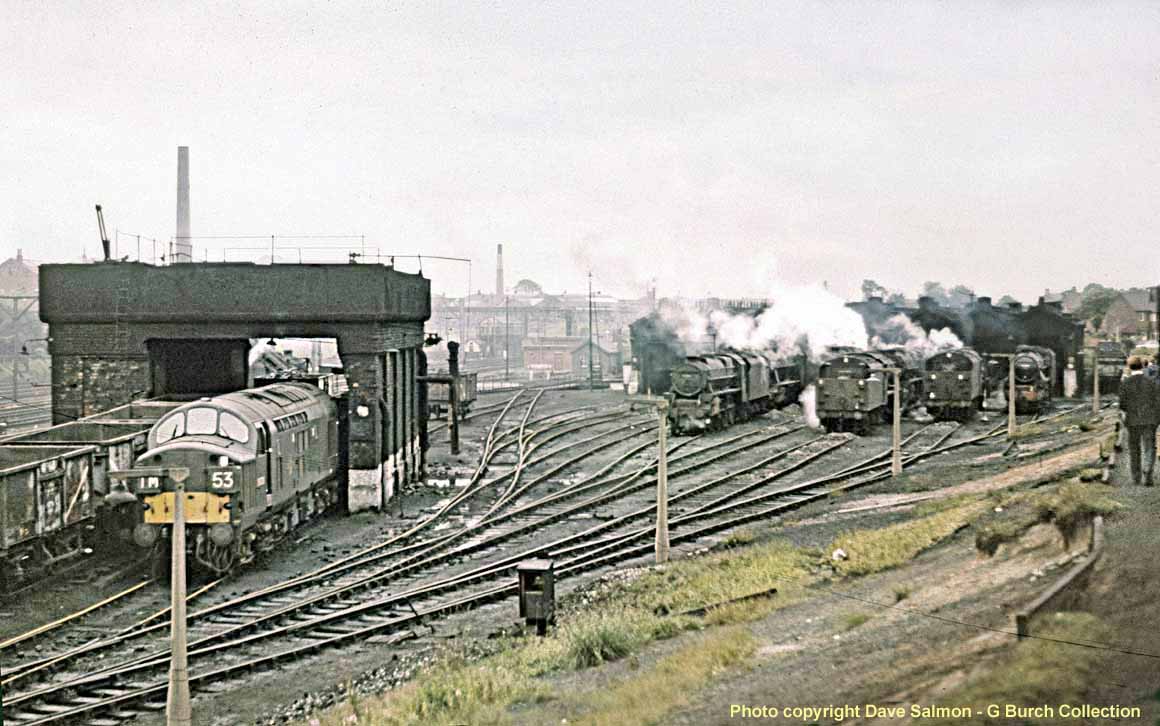

(Above-Below) Three Stanier engines Nos 48437, 44725 and 45454 nearest are among the accumulation of machines alive and ready for action at 9B. (Below) This line up of locomotives at Newton Heath MPD (26A) include a proliferation of Black Fives No's 44891, 44803, 44940 and 44802, and a Class 8F No 48321.
(Below) Class 9F No 92126 at Heaton Mersey (9F): a captious and disparaging viewpoint may well say these engines were flamboyant beasts of gargantuan proportions, where the loading gauge has been pushed to the limits, reminiscent of an interim stopgap, a temporary substitute or an alternative fall-back biding its time before the inevitable end came knocking; the towering jumbo was a mammoth machine that was alright travelling in a straight line, but very susceptible to derailment when negotiating tight curves, such as often found within shed and freight yards. The lamentable state of the battered hulk still shows through the swathes of steam and smoke, the miscellaneous bumps and knocks are illuminating; clearly the lookout for the lesser unassuming driver is a considerable challenge, a confrontation on a daily footing, a trial of mind and mental strength, but what the heck! Another knock here, a bump there…will anyone take note, for surely this one is just scrapyard fodder? 
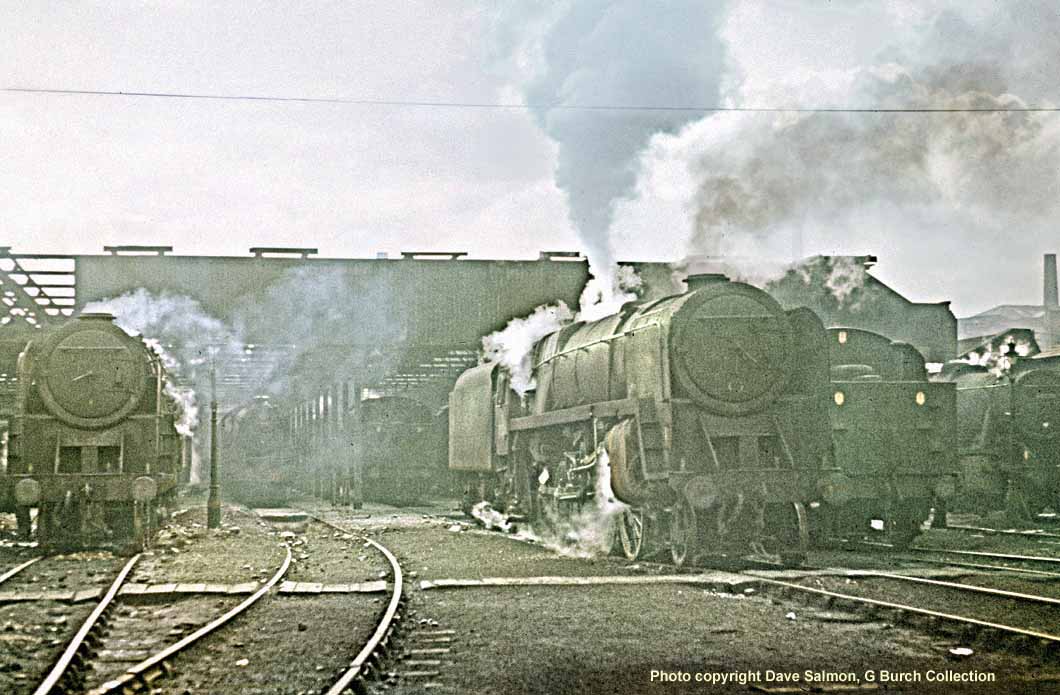
(Above) BR Standard class 9F No 92126 is fully set for action as the excess of steam roars from the safety valve high into the air at Heaton Mersey freight shed, to the west of Stockport. Identification from this angle is impossible and only close inspection can distinguish one engine on the right from its classmate on the left. The level of dereliction of the whole ensemble is quite plain to see, a whole world away from that portentous day I first entered a steam shed, where the orderly lines of locomotives were set relatively neatly and access gained along clearly defined pathways in between. But by the 1960s, order has been replaced by abandonment across much of the country; steam has had its day and being tossed aside for a new wave of locomotion, threadbare facilities have descended even further to the point of desolation and decay, the end may well come as a huge relief to all concerned.
(Below) Looking in the opposite direction at Heaton Mersey shed, BR Standard Class 9F No 92157 awaits her next turn of duty. To the all-seeing eyes of the beholder, this is a scene of total dilapidation, hardly any romance or atmosphere at all, even from the furthest corners of one's mind. All around vestiges of our evocative past visits are hidden behind cobwebs…for here is no wonderment here, the detritus and jettisoned debris banishes all good thoughts, just bewilderment at the extent of the swift fall from grace of a relatively new class of engine fighting to keep the wheels turning despite the crumpled aspect. The leaking exhaust joint and lack of maintenance are plain to see, yet the rusting metal giants plod on to their bitter end to be disposed of as you would a tin-can, cast aside in the name of progression. Lacking any forward nomination of residence or number the man-made hulks bide their time before their next calling amid the clutter, a run to Birkenhead Docks with container traffic, possibly, or perhaps soda ash hoppers for the ICI at Winnington. But no matter…their most useful days were now some way behind them, even though there were still some 77 of this class left in service by this date of July 1967, mainly for the reason of their youth. 

(Above-Below) It is doubtful if Chief Mechanical Engineer, William A Stanier would have envisaged anything at all similar to these scenes at Heaton Mersey shed when he designed the 2-8-0 heavy freight locomotives for the London Midland Scottish Railway in 1943; the Class 8F design was a direct descendent from his very successful 'Black Five' 4-6-0 engine. With less that a month to go before expiry in August 1967, Class 8F No 48208 - a long-time resident of Heaton Mersey freight shed - is flanked by other Stanier machines resting in the shed's hazy environs, a scene best described as an aura of wonder, a mystical, even magical perception of strong light and dark shadows splendidly encapsulated by Dave Salmon's eye for a great picture; he selected the venue very well indeed. 
(Below) Sunlight streams through the shed roof in this atmospheric scene of more 'heavies' languishing at the rear of Heaton Mersey's 8-track straight shed. Class 8F 2-8-0s Nos 48329, 48464 and 48720 (centre and left) were built by Crewe Works, Swindon Works and Brighton Works respectively between April 1944 and January 1945. By 1965 there were still twenty of the same engine type still operating from this ex-Cheshire Lines Railway depot, along with 13 'Flying Pigs' and 3 class 4MT 2-6-4T tank locomotives. Again the multi-pitched roofing and wooden truss structure create a strange ambience that draws us in, an alluring vision of wonder, stoking our emotions of not wanting the moment to diminish, even if the awareness of near death is strong and forceful.
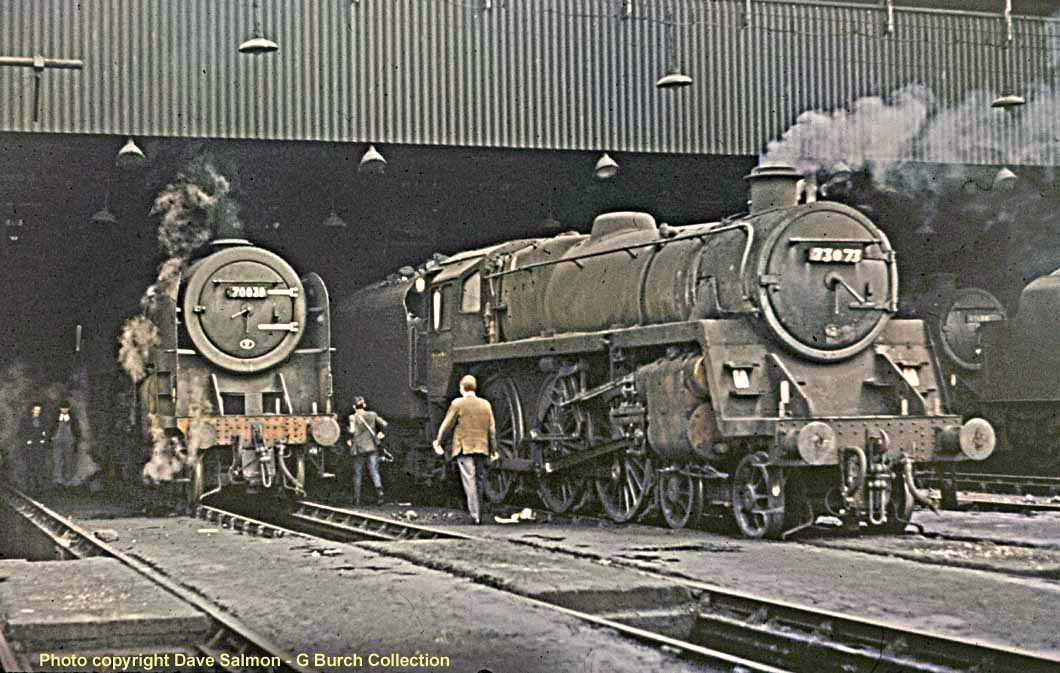
(Above-Below) A profusion of lamps overlook the fuliginous atmosphere of Patricroft's 8-road Old Shed as a pair of number-collectors reconnoitre the dark paradox within, holding the idealism that 'its not what we see, but how we see it' that is paramount to their beliefs. For them, steam locomotives still had a future despite what the BR Chairman Dr Beeching had declared. The visual aberration of two colour destitute engines brewing up in readiness for their next duties conveys anathema to all enthusiasts, to each of us that have experienced the emotional high of being in the presence of these living and 'breathing' metal giants at close quarters; it entices so much enthusiasm, encouraging generations of enthusiasts to model their environs and capture their images on film, or for writers to record every solitary detail of their past, present and future. Here BR Standard Class 4-6-0 No 73073 is but days away from an ignominious withdrawal from Patricroft, the very same depot it was initially allocated back in 1951. (Below) Carlisle Kingmoor's BR Standard Class 7MT 'Britannia' Pacific No 70039, now minus its Sir Christopher Wren nameplates, stands loud and proud in the sepulchral gloom that was Patricroft (9H) depot. The 'old' shed was a commodious affair situated to the west of Manchester City Centre; indeed the site was unique because of the positioning of the New shed (1901) which was set at right angles to the Old shed (1884) due to the location of the coaling tower in between. The spurious number plate is highlighted by the somewhat garish overlay of whitewash that also marks the smokebox door hinge straps, though these brighten what is seen to be very drab, discoloured paintwork, which looks in desperate need of some 'TLC'…but, of course, that is just not going to happen at this late juncture. The ex-Great Eastern stallion was recorded by none other than Mr Cecil J Allen, on a very spirited run from Norwich to London, a journey considered to be remarkable as it was completed almost in its entirety with the steam cut-off at 40%, displaying the quite unrivalled ability of the Britannia boiler to produce steam.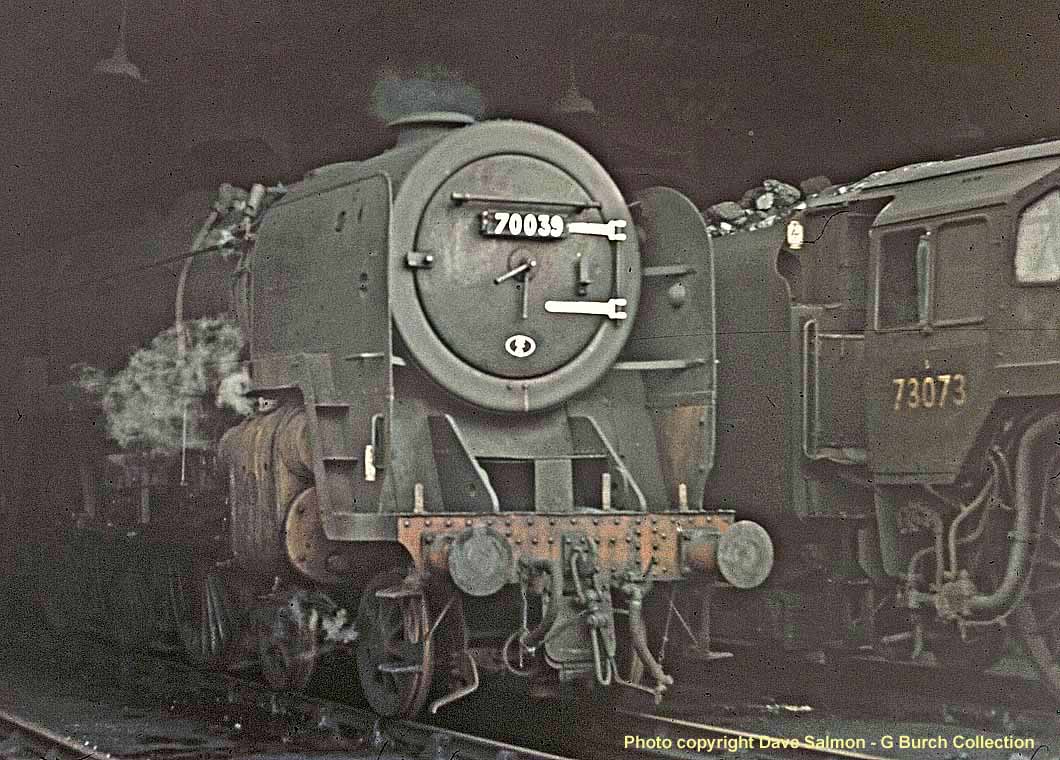

(Above) Moving along the WCML's up slow line at Warrington to collect yet more coal wagons, Stanier 'Black Five' 4-6-0 No 45089 of Crewe South shed (5B) is eking out its final days after a career spanning more than 30 years, starting in 1935 based at the same shed. For a generation of spotters the everyday sight and sound of a working steam engine was all encompassing; the sweet bouquet of steam filled our nostrils, the alluring aroma enveloped all about us and lingered awhile, but we never tired of that scent; it clung to our clothing and hair, the effluvia that accompanied the steam workhorse was one to be savoured. For a spotter such moments were greatly desirable, and in this case he didn't have to wait long for a repeat performance; no sooner has the locomotive passed beneath the road bridge, and his senses remain alert and expectation levels rise again as yet another 'Black 5' on a southbound goods train can be seen held at signals in the distance. The scene is completed with all the railway infrastructure of a busy junction; the common sight of a 204 hp diesel-mechanical shunter on the right adjacent to the signal box and the coal sidings. The down fast line is very notable for that big camber, which looks as though it has recently been reset, most likely in readiness for forthcoming electrification north of Crewe, thus allowing greater speeds for a new generation of soulless electric locomotives…which, for spotters, meant his visits to the lineside would never be the same again.
(Below) Stanier Class 5 4-6-0 No 44661 of Stoke (5D) wheels its train on the up Slow line through Warrington Dallam Junction in June 1967. With just a single engine in charge, the nuclear flask is most likely empty enroute from the Sellafield Plant in Cumbria to Dungeness Power Station. Had the flask been full then two locomotives would be used as a precaution against engine failure. Warrington Gas Works is prominent in the right-background and much concentrated building work is ongoing in the centre of the picture. Typical for the area is the flat-roof style signal box which controlled the junction and movement in and out of the shed complex at Dallam (8B), just behind photographer, Dave Salmon, whose cognizance for capturing a good picture is clear to see. The image gathers all the relative railway infrastructure and displays the strong links that both local and large industries had on the supply chain the railways provided for so many years. Seen to the right-hand side are extensive coal movements still extant for the Gas Works, later subject to an IRA bomb attack.

(Above-Below) Two enticing views, both drawing the onlooker in…the focal point in the above shot is, of course, the 'Black Five' No 44661 heading south through Warrington Dallam Junction with a mixed goods that includes a nuclear flask on a six-wheeled well-type wagon, but if we scan the remainder of the picture all the paraphernalia of a busy railway junction is pretty much contained within this one shot; we can identify 24 open metal coal wagons; 9 wooden bodied wagons; 7 bolsters, 6 box vans and 9 iron-ore hoppers, not to mention a solitary guards van and also 3 oil tank wagons. The yard in the triangle of lines belonged to Lancashire Steel while the viaduct carried the Liverpool to Manchester line which connected with the Warrington Central line at Padgate. The whole wondrous scene is perceived from Folly Lane bridge leading down to Kerfoot Street; Warrington Dallam running shed is just out of sight to the right-hand side adding extra vantage to an already complete image.(Below) Class 8Fs Nos 48363 or 48365 stand among several Black 5s and a Class 9F at Warrington Shed. 

(Above) The sight and sound of an approaching steam engine was all encompassing, the emotions kicked in, the reflexes were heightened, the target was in view…and nothing, but nothing can prevent us from recording its number. Alas all of this is about to change, for it is July 1967 and there is little more than a year left for BR's remaining steam workhorses. The sharp downturn in steam locomotive numbers reflected heavily on the few remaining engines pressed into in service and this is emphasised by a very down-at-heel Class 5 No.45149 passing through Wigan with a passenger train comprised of at least one respectfully clean-looking leading Mk2 carriage.
(Below) Although the heydays of BR steam have long since gone, the emotive experience is still there; perhaps it's a memory we have of searching for an elusive locomotive that our spotting mate had 'copped' during his solo trip to Blackpool the other week; the fervent adventurer seeking out the living beast in foreign parts, the powerful aroma of steam pervading the air as we entered the gloomy shed interiors or roamed the shed yards where our captures lurked. Here, Class 5 No 45395 stands at the head of a line of locomotives at Wigan MPD. 

(Above) With steam in rapid decline during the 1960s, scenes like this at Wigan Springs Branch shed will soon be gone forever. No more dashing to catch the '10.00am' from Manchester; no more lingering on platform ends to jot down numbers in our dog-eared notebooks. For the legion of ardent spotters the heady days of cycling to faraway places and spending long hours by the lineside will soon be a distant memory, yet some scenes remain embedded in our minds for ever. A perfunctory inspection of Dave Salmon's shot of Wigan Springs Branch shed yard shows the closed ranks of engines with many in store. A large number of engines were allocated to Springs Branch during the last six months of 1967, almost exclusively Stanier locomotives with a sprinkling of BR 4MT 4-6-0s; the shed's allocation even at this late stage comprised 35 'Black Fives' and 24 of the '8F' 2-8-0 class. The view from the back of the shed is to the south west and takes in the Springs Branch No 2 signal box as well as the Moss Sidings box to the left and shows at least 21 engines in the line up, all seemingly of Stanier pedigree, but possibly only '8F' No 48752 is ready for some further action.
(Below) Although the eradication of steam was most definitely on the landscape, here the scene is still as per normal with two Stanier 'Black Fives' taking centre stage at Liverpool Edge Hill depot in August 1967. When William A Stanier reigned as Chief Mechanical Engineer of the LMS from 1932 to 1944, he elevated the company to the forefront of passenger rail travel. The pinnacle of his work was the beautifully proportioned 'Princess Royal' Pacifics followed by the 'Coronation' Class Pacifics, but then all his locomotive designs were innovative and bearing all the hallmarks of his expertise, howver many enginemen claimed the 'Back Five' to be the star performer. Allocated to Bushbury (3B) in Wolverhampton for 14 years, this very grubby No 45287 in the foreground was a 'last day' survivor, whilst the somewhat cleaner No 45493 on the embankment in the background, was a later arrival on the scene being in built in 1944 and spending most of its career at Rugby (2A) shed, but by 1967 the loco was on the books at Carlisle Kingmoor (12A).

(Above) One name that is synonymous with the city of Manchester is undoubtably 'Trafford'; its prominence goes back more than three centuries culminating in the Trafford Estates, an expanse of land that formed the site of Europe's largest industrial estate, namely Trafford Park. From as early as 1895, the commodious engine shed has served all manner of locomotives right the way through two World Wars, officially closing late March 1968. This image reflects the many 'iron horses' stabled overnight in what was the shed's last complete year of operation. The 23-road open-ended depot supplied the motive power required by nearby Manchester Central station, inclusive of many ex-Lancashire & Yorkshire Railway types, as well as a raft of freight engines. A very commendably clean floor surface suggests good housekeeping instructions in place even at this very late stage and the ranks of Stanier designed locomotives would be well illuminated by the many suspended lamps overhead.
(Below) The prospect of visiting a loco shed for the first time was an exciting time for a young spotter; what 'gems' would we find hidden within, maybe a foreign engine biding its time among the inner recesses of the building before heading back home. Even more daring was 'bunking the yard', sneaking around the back out of sight of the Foreman's office, taking great care around live engines in steam, and extra caution was needed to avoid open pits when crossing the tracks. Viewing the huge Class 9F machines from ground level was daunting; their magnitude awesome; the only true freight loco to be designed with smoke deflectors. Here BR Standard Class 9F No 92048 rests at Trafford Park MPD. Built at Crewe and allocated to Wellingborough (15A) in February 1955, her last shed was Birkenhead Mollington Street (8H) and she was withdrawn from service in September 1967. 

(Above) For the benefit of the discerning modeller, comparisons can be made with the later built BR Class 2MT 2-6-0 Mogul tender engines (featured below) in the 78000-64 numbered series to the earlier ex-LMS 2-6-0 class engines Nos 46400-46527 as designed by Robert Riddles and his team at Derby from late 1952. These earlier built machines provided the model for the later versions, being designed by HG Ivatt with critical help from TF Coleman, a locomotive designer at Derby at that time. Looking at the front firstly, the vacuum standpipe remained as built and was not shortened in any way; the front steps were skeletal, ladder-like with no backing at all; there was no sloping valance in front of the valve assemblies or any lubrication pipework to clutter the front of the smokebox saddle, but there was a top-feed fitted to all class members contrary to the later '780XX' engines, which had a clack valve system instead. Furthermore the boiler handrails were very different in design and size, as this type were horizontal, end to end and of equal length, being more symmetrical with the smokebox handrail; the exhaust ejector unit bore a number of differences from new, but also later in service saw some changes to the Western Region engines, as with the WR 'Britannias', a control valve was added to the topside of the ejector unit, with wiring back to the cab giving the driver more control over its operation, while these earlier engines carried no conduit to protect the pipework from the front of the cab to the smokebox fitment. The main difference between the two classes evolved around the cabs, to which Riddles paid much attention, though crews still found cause for complaint, apparently. The side and front windows were different from one model to the other; Ivatt opted for larger windows than were found on the later locomotives and used a flatter shape to the cab roof; also a 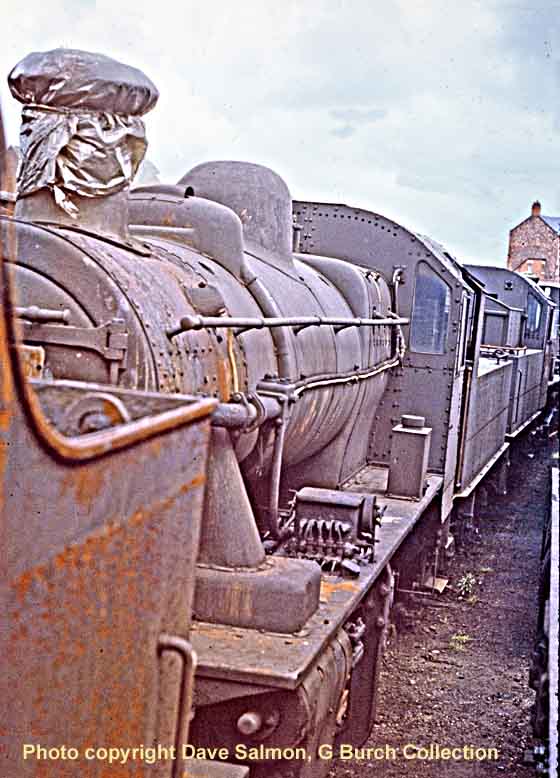 long line of 26 small vent holes, with an astute gap in the centre, were drilled near the top edge of the cab front (spectacle) panel, plus the side sheet panels were plain with one rounded corner as opposed to a distinct horizontal crease just above the BR number, accompanied by a sharp angled cut-off for the lower leading corner, this design, apparently, gave the engine absolute clearance to traverse any rail lines in the country. Even the cab roof rain gutters differed somewhat, as Ivatt chose a slightly angled strip to run the rain to the front of the cab, while the later models reflected a thin horizontal fillet to allay the rain effect, as used on all standard models. The cab steps were wholly attached to the tender frame, but were mostly very substantial and adequate for the job having sturdy, vented backplates unlike their modern counterparts, which were far slimmer with a full backplate; also the two grab rails (cab and tender) were formed of three pieces, the rail and two socket ends, but were just one section on the newer engines. Other minor differences have surfaced when comparing the Ivatt engine to the Riddles model apart from the obvious short regulator rod on the nearside of the Standard type, but the only one of note was the grab handle at the rear end of the BR3 tender, this was not seen on all of the 464XX class except on a few engines; e.g. '46509' which was treated to green livery at Swindon Works and possibly they upgraded the fittings for those that they constructed (Nos 46503 to 46527).
long line of 26 small vent holes, with an astute gap in the centre, were drilled near the top edge of the cab front (spectacle) panel, plus the side sheet panels were plain with one rounded corner as opposed to a distinct horizontal crease just above the BR number, accompanied by a sharp angled cut-off for the lower leading corner, this design, apparently, gave the engine absolute clearance to traverse any rail lines in the country. Even the cab roof rain gutters differed somewhat, as Ivatt chose a slightly angled strip to run the rain to the front of the cab, while the later models reflected a thin horizontal fillet to allay the rain effect, as used on all standard models. The cab steps were wholly attached to the tender frame, but were mostly very substantial and adequate for the job having sturdy, vented backplates unlike their modern counterparts, which were far slimmer with a full backplate; also the two grab rails (cab and tender) were formed of three pieces, the rail and two socket ends, but were just one section on the newer engines. Other minor differences have surfaced when comparing the Ivatt engine to the Riddles model apart from the obvious short regulator rod on the nearside of the Standard type, but the only one of note was the grab handle at the rear end of the BR3 tender, this was not seen on all of the 464XX class except on a few engines; e.g. '46509' which was treated to green livery at Swindon Works and possibly they upgraded the fittings for those that they constructed (Nos 46503 to 46527).
(Below) Like common criminals these five engines have been arrested, held-up at the local station and shepherded into a straight line for a sharp, yet sympathetic eyewitness observation at close quarters to identify the usual characteristic traits. This is the truly sorry sight of young BR Standard locomotives taking part in a last line-up at Bolton shed, an identity parade that has but one outcome, with no release for anyone from custody, save to lasting involuntary confinement in a faraway yard. Suspect '78013' remains vigilant, staying put and hoping the game is not up, maybe '78007' will be found wanting, though '007' was always very resourceful, persistently avoiding any issues with unshakeable aplomb. Maybe one of the others would succumb, '78012' or '78023' were the same age, of similar condition and from equivalent stock. They were always together in Manchester, seen many times in Trafford Park before turning up here in Bolton. Eight BR class 2MT 2-6-0 locomotives found themselves stranded at Bolton depot by November 1966 and were withdrawn either in February or May of 1967. Nos 78007/12/13/23/44 & 78062 were all present when Dave Salmon captured this photo and all 6 were purchased later in the year by A. Draper of Kingston upon Hull for scrap. These were kept company by BR Standard Class 5MT 4-6-0 Nos 73004 and 73156, which managed to secure a position on the East Lancashire Railway following its rescue from Barry Scrapyard.

(Above) Looking to the west from the very convenient footbridge at Patricroft, this image encompasses the local station and goods yard as well as highlighting an unusual overhead angle of BR Standard Class 5 4-6-0 No 73157 entering the shed yard for refuelling. Many of these 4-6-0 types were allocated here throughout their rather short lives, including some fifteen engines when brand new, being used on the Edinburgh services as far as Leeds and many turns to North Wales. A very intriguing shot full of interest which also shows evidence of track removal to the right and the square point rodding to the left indicates the station signal box is just out of picture; also the general clutter lying aground includes a completely collapsed 4-wheel trolley. No 73157 spent its last thee years at 9H, having started its first year on the Eastern Region working out of Kings Cross shed. The engine was amongst 52 built at Doncaster Works, with the  mainstay of the class being constructed at Derby, but these locomotives worked all over the BR system, from as far afield as Nine Elms and Corkerhill to Carmarthen and Carlisle, though less apparent on the Western Region lines. A spurious front number plate does very little to enhance the aesthetics of any engine, but the general demeanour of 73157 is now one of a rather run-down machine that has been well used, but now a tool to be abused and soon to be put down…not as fortunate as its classmate No 73156 which is now preserved at the East Lancashire Railway.
mainstay of the class being constructed at Derby, but these locomotives worked all over the BR system, from as far afield as Nine Elms and Corkerhill to Carmarthen and Carlisle, though less apparent on the Western Region lines. A spurious front number plate does very little to enhance the aesthetics of any engine, but the general demeanour of 73157 is now one of a rather run-down machine that has been well used, but now a tool to be abused and soon to be put down…not as fortunate as its classmate No 73156 which is now preserved at the East Lancashire Railway.
(Insets) To celebrate the age of steam and the role that both Patricroft station and motive power depot played in the grand scheme of things, Wigan-based graphic designer Mark Mennell, a creative innovator of wall art from metal, wood and mosaic, has recently been commissioned by the Friends of Patricroft Station, Salford Community Leisure and Northern Rail to produce a set of lightweight information panels and  artwork which can now be seen on the station's Liverpool platform. The artwork contains a number of Information panels giving the viewer an insight into the area's rich history; there are also panels based around the story of the Stanier 'Black 5'; incidentally No 45156 Ayreshire Yeomanry' was the last engine to leave the Patricroft Shed driven by none other than Footplate Cameraman Jim Carter (see pages 66-68).
artwork which can now be seen on the station's Liverpool platform. The artwork contains a number of Information panels giving the viewer an insight into the area's rich history; there are also panels based around the story of the Stanier 'Black 5'; incidentally No 45156 Ayreshire Yeomanry' was the last engine to leave the Patricroft Shed driven by none other than Footplate Cameraman Jim Carter (see pages 66-68).
The artwork is produced by digital printing onto lightweight composite panels, necessary due to the age and condition of the platform walls. Mark also specialises in the delivery of many other inspirational art projects designed to bring something special into the lives of everyday people, such as local community groups and schools through to large public and private sector organisations. The impact of his metal artworks, mosaics, painted murals and printed graphics are not only striking, but suitable for a range of even the most demanding environments - and I just love the way Mark's art is cheering up some of our drab stations; click HERE to contact Mark should you wish to discuss a potential project.
(Below) On Saturday 2nd April 2016, the Ceremonial Mayor of Salford, Councillor Peter Dobbs, visited Patricroft station to inaugurate the panels. This group photograph was taken in pouring rain following the opening ceremony and shows from left to right: Alan Davies, the Mayor's consort; the Ceremonial Mayor of Salford Councillor Peter Dobbs, and on the right Chris Carter and Mark Mennell...more details can be found on Chris Carter's 'Footplate Cameraman' website HERE. 

(Above) By way of a change this classic shot of Patricroft station looking towards Liverpool was taken by Footplate Cameraman, Jim Carter, from the lofty height of Patricroft shed's coaling tower. Following closure of 10C in 1969 and the subsequent redevelopment of the Royal Ordnance Factory into a business park and modern housing, the industrial heritage of Patricroft has changed forever and this scene is barely recognisable today. Photo courtesy Les Moor.
(Below) A wonderful view afforded by the old footbridge at Patricroft depot (10C). A total of 73 engines were allocated to 10C in 1950, including 36 'Black Fives', 16 'G1/G2' 0-8-0 locos and 5 'Jubilees' of which No 45563 'Australia' was a long-time resident. By 1959 (now coded 26F) there was a slight increase to 78 locomotives, but eighteen of the 'Black Fives' were now replaced (not directly) by eleven BR Standard Class 5 4-6-0s, some arriving brand new off the production line. The shed code changed again in 1963 to 9H, and while the same number of locomotives remained, more BR Class 5 Mixed Traffic 4-6-0 types arrived, mainly those fitted with Caprotti valve gear (ten of twelve) a number which doubled to twenty in 1965. The shed remained operational to the last day of June 1968, by which time the eight-road 'Old Shed' (seen on the left) had existed for 84 years, albeit many changes to its roof and actual size have taken place during that time. 

(Above) All the world's a stage, they say, and it's true; it even manifested itself in the world of train spotting for the everyday dramas to be witnessed by spotters were not too far removed from the highbrow Shakespearean tragedies enjoyed by theatregoers. From our position on the upper circle, the star of the show moves forward to take centre stage; clearly the machine is very much alive and its presence excites the senses, the fireman is building up the fire before producing a loud burst of power and the ensuing display of pyrotechnics grabs our attention. No 48335 made its debut in 1944, performing regularly to matinee audiences for more than twenty years, but there's a paradox…the puzzle is not what we are viewing, but how we view it? Does the vision appeal to the inner soul of the beholder; is he smitten and completely hooked, does he wish that steam is immortal and should not end? Master 48335 has wowed audiences far and wide, starting out at Swansea Victoria, moving on to Bescot and Willesden before featuring at Patricroft - all under the Directorship of Sir William A Stanier.
(Below) Stanier '8F' No 48491 heads away from the confines of Patricroft shed yard, leaving behind the discord of a depot eking out its time in tune with other surviving steam centres, a scene of discarded lumps of coal, damaged and sunken rails, and much ash trodden down over so many years. In melodious terms, melancholy has replaced harmony, the triumphant coda being played out with a dirge, this particular 'long song' has now reached its finale, the music of the day (and night) of distant rolling thunder, the strong rhythmic beats from the pulsating exhaust notes of an approaching train will no more be heard at regular intervals on the main line to Manchester Exchange and beyond. By 1967 there were a total of 307 ex-LMS engine types that lasted out the penultimate year of steam, ready to see some more action for the last months, inclusive of No 48491, which was withdrawn in June of 1968..

(Above) As with most Class 9F members, the front end of No 92133 did not escape its share of daily knocks and scrapes; the bruised and battered loco is well blackened, filthy and grubby in the extreme, with layer upon layer of soot and grime hiding its identification from the casual onlooker; only the most ardent spotter would be able to record any such number from very close quarters. The 9Fs were never much to view aesthetically; upon closer inspection the ungainly space between the front bogie axle and the first drive axle is only outdone by the ugly gap between the boiler and the middle drive axles, whilst the external plumbing on this side scores very low marks. In reading through the history of these engines, ES Cox was confident the new engine configuration would be a 2-8-2, but he was overruled by his superior the Chief Engineer for the Railway Executive, Robert Riddles. In all, 18 Class 9F engines survived into 1968 with the last going in June - Nos 92077, 92091, 92160 and 92167 all from Carnforth depot. 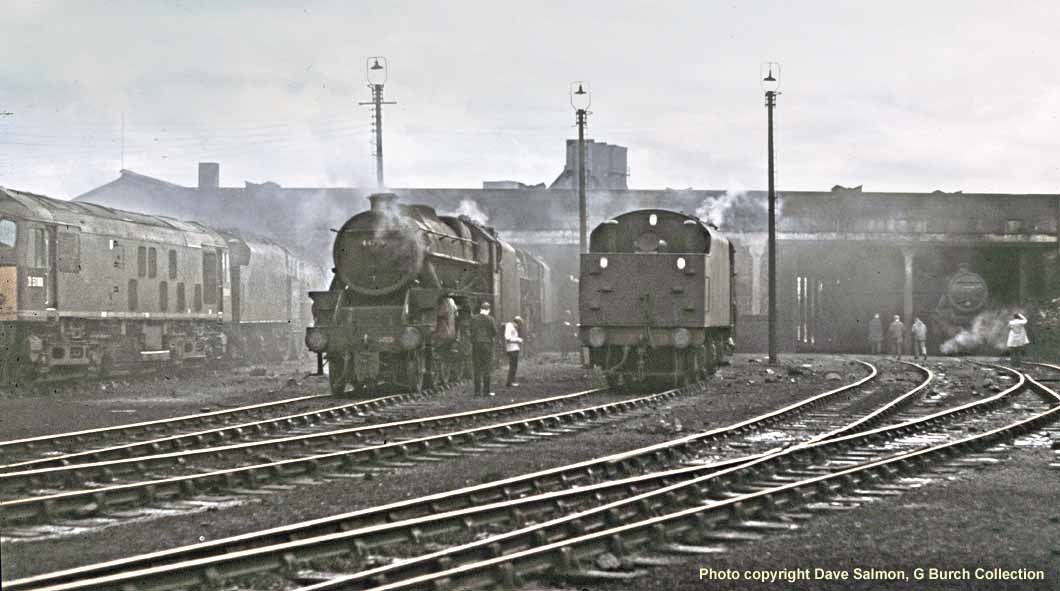
(Above-Below) A general view of Workington shed yard. (Below) A proliferation of 'Flying Pigs' was a prominent feature of Workington shed's allocation, being used on local freight turns as well as passenger services to Maryport and onto Carlisle Citadel Station, or directly eastwards to Penrith. Also known as 'Doodlebugs' these useful lightweight Moguls were to be found all over the country with the possible exception of London city centre. Many started out their careers on the Eastern Region at Peterborough's New England shed, but also saw plenty of service at Boston (40F), Melton Constable (32G), Lincoln (40A) and Colwick (40E). On the London Midland Region, Nuneaton (2B) was a regular venue for these Ivatt 2-6-0's, with Cricklewood (14A), Derby (17A) and Heaton Mersey (9F) also reflecting many more allocations during the early 1960s. The initial engines had a double chimney and blastpipe, but after experiments with No 43027 (seen here) and further testing on 43094, all class members sported the single version which was fitted as standard from No 43050 onwards. Six engines succeeded in last out until 1968, with No 43027 being withdrawn in March and No 43106 fortunate enough to be preserved and now to be seen on the Severn Valley Railway. It is noticeable from Dave Salmon's image that all engines appear to have AWS fitted; it seemed strange that some minor engines were fitted whilst many express passenger locomotives were not so, possibly down to repairs at Doncaster Works, while operating on the Eastern Region.

(Above) A long-time resident of Carlisle Kingmoor shed, Stanier stalwart 'Black Five' No 44902, stands alone at its home depot on 22nd January 1968; this former Caledonian Railway engine shed (68A) was transferred from the ScR to the LMR in 1958, later to become a Mecca for countless thousands of ardent spotters wishing to pay their last respect to the last survivors of steam while there was still time. Camera lenses were pointed in all directions to capture all manner of subjects before the final curtain came down, a final glimpse of filth and neglect, a long lasting memory of steam's endless struggle against the odds. Although Kingmoor shed officially closed on the last day of 1967, it remained one of the last outposts of steam right the way through into 1968 and many sojourns were made to Cumbria, a pilgrimage of immense importance for enthusiasts. Meanwhile compacted ash almost hides the rails as Class 5MT 4-6-0 No 44902 awaits attention. Built in October 1945, this reliable and very capable engine still looks keen for more action; 44902 is equipped with the small version of snow-plough which has seen much activity and bears the scars of battle to prove just that.
(Below) Although fully laden with coal, this forlorn-looking BR Standard Franco-Crosti Class 9F 2-10-0 No 92022 may be out of use at Carlisle Kingmoor; its official withdrawal was due to take place the following month; the loco was scrapped by Campbells of Aidrie in April. The concept of the Crosti system was that the outgoing exhaust gases were reversed through a preheater (similar to a smaller boiler) to heat the cold water before its entry into the main boiler. The standard funnel was retained for lighting-up only and blanked off manually at the front of the engine prior to running. The actual exhaust chimney was located in front of the firebox on the right-hand (fireman's) side, but this led a constant source of complaints by engine crews due to smoke entering the cab. Following operating experience, it was discovered that the Crosti preheater provided less improvement than expected plus the maintenance of the locomotives proved to be a problem owing to a build-up of Sulphuric acid in the feedwater heater causing corrosion. All were converted back to standard form within a few years although the preheaters remained in place, but these were blanked off and the locomotives were down-rated from 9F to 8F due to the main boiler being smaller, which, in my opinion was self-defeating. The additional running costs rendered these machines a non-starter as the savings in coal consumption needed to be in excess of 20% to recover the extra outlay. Most of the class of 10 engines were originally allocated to Wellingborough (15A) depot for hauling the heavy coal trains from the Midland coalfields to London, but after the Crosti experiment was abandoned the engines ended up in the main at Birkenhead (8H), but only for the reason of recouping some of the outlay. As for No 92022? Built at Crewe in March 1955, a completely farcical situation came about just four years later in May 1959 when the engine was withdrawn from traffic and put in store for THREE years awaiting conversion back to a conventional engine, thus No 92022 had an active service life of just nine years, during which time the recorded annual mileages were lower than even shunting engines.

(Above) All good things must come to an end, but the headlong rush to condemn twenty-odd thousand steam engines during the 1960s was a tragic and shocking waste of money, some engines were just five years old when their careers were terminated; this included recently overhauled engines in ex-works condition with plenty of life still left in them which were eliminated for good. But then the need for speed was the driving force behind the 1955 Modernisation Plan, the desire for a fleet of more modern traction was paramount to the BTC, notwithstanding the wonderful role carried out by the rank and file of steam locomotives and their relative crews, or the shunters and the signalmen, the porters and guards, all of whom played their part in improving the stock of the railways to a position of strength following the difficult war years. Whilst Dave Salmon wandered around Carlisle's well-known last outpost of steam, he aimed his camera at Ivatt 2-6-0 'Flying Pig' No 43139, BR Britannia Pacific 70052, formerly 'Firth of Tay' with classmate No 70025 previously named 'Western Star' along with a withdrawn 'Black Five' and a '9F' 2-10-0 engine. 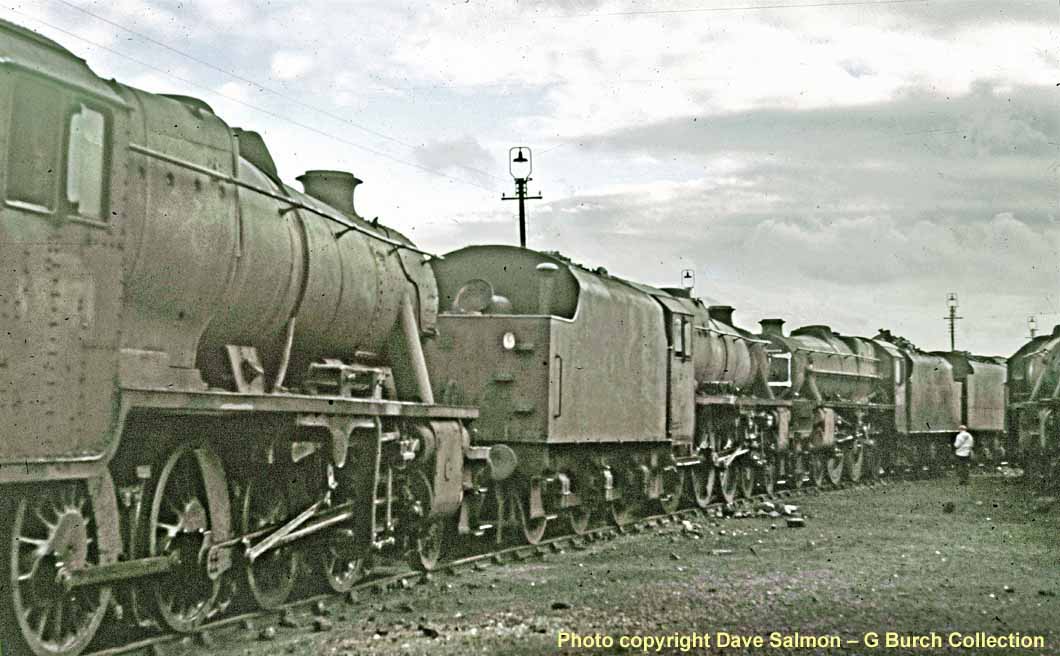


(Below) Fifteen year-old 'Britannia' No 70014 Iron Duke looks downtrodden and abject in appearance, a far cry from his best appearances on the prestigious 'Golden Arrow' during the engine's sojourn at Stewarts Lane depot; gone are the sparkling buffers, the polished cylinder head covers, the fastidiously burnished paintwork and the highlights on the smokebox door hinge-straps. There is a vague hint of Brunswick Green colour about the livery, though this is mostly undetermined and muddy in its entirety, while many changes have occurred since leaving East London some nine years prior, including the late additions of AWS equipment and the fitting of a speedometer in April 1962. The lateness of the speedometer was a great irony in my view. No 70014 had made all those prestigious trips to the Kent coastline on the Southern Region without any guidance for the crews, yet these units were added to the last ten Britannias Nos 700045-54 as far back as 1954! Looking at the front of the engine we should notice that the number plate has been changed to a non-original fitment having a red background, while the topmost lamp iron has been moved down the smokebox door in line with crew safety issues; this was a GE type which was longer than any LMR version. Also of note, as so often happened with these Pacifics, the front buffer assembly has been knocked up, detectable by the buckled fall-plate. The angle of the front valance was worked out to be best set at 67 degrees and while the original line diagram displayed a proposed double chimney, it was, of course, always perceived as a single unit, although Mr Sam Ell of Swindon Works had preconceived ideas following the success of his team of engineers with the fitting of double chimneys on the WR 'Kings' and 'Castles' from 1955 to 1956. However, he found the alterations made minimal difference to the overall performance of the Britannias. No 70014 was noted for an ignominious incident in July 1958 when the locomotive 'lost is train' (it broke away from the tender) at the head of the 'Palatine' express near Cheadle Heath and the immediate loss of vacuum rendered the brakes inoperable; the driver was commended for bringing the 'runaway' to a halt by the auspicious usage of the reverser.
(Below) The thrill of the chase, the headlong rush to far-flung destinations; such marathon journeys raised an intrepid spotter's emotional excitement to a whole new level. No hidebound rules here, only freedom to roam and inspect the rusting hulks before they are finally removed for their last journeys. Here BR Standard Class 4 4-6-0 No 75027 shares the company of Stanier Class 5MT No 44932, both engines being officially withdrawn in August 1968, though quite clearly they are in a 'wheels not turned for a while' state at Carlisle Upperby (12B) in October 1967. The original eleven track straight shed building was turned into a 32-road concrete roundhouse in 1958, but this closed in December 1966. The shed was home to many passenger express engines, but following the end of steam the buiding was deemed surplus to requirements. No 75027 was bought direct from BR for preservation by the Bluebell Railway in Horsted Keynes, East Sussex; the engine started out at Plymouth Laira (83D) in May 1954, then saw good service at Oxford before embarking on a 'tour' of sheds in the North West. 

(Above) Built at Crewe Works in 1950, Ivatt Class 2MT No 41264 was allocated initially to Blackpool Central (28A) before being transferred to Low Moor (56F), followed by moves to Wakefield (56A), Mirfield (56D), Low Moor (56F), Warrington Dallam (8B), Southport (8M), Carlisle Upperby (8A) and finally Carlisle Kingmoor (8B). In July 1967, Ivatt's Class 2MT 2-6-2T stands at the already closed Carlisle Upperby depot awaiting its fate. Although withdrawn way back in December 1966, eight of these engines saw service on the Southern Region the following year, but they were gone by August 1967. No 41264 is notable for its mechanical lubrication units and external pipework along the water tank lining for the vacuum pump; note also the lack of a small footstep on the coal tender inset, seen on most of these engines. With operating rods removed for ease of movement the end was not far away, as was the case for 98% of steam at this time, but still worthy of a concentrated inspection for any discernible modellers, especially the remarkable shape of the rear end of the tender and the clearly defined '1' depicting class 1MT visible above the cabside number.
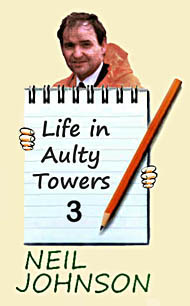 If a publisher was seeking a sure fire winner to add to their list of new titles then they need look no further than former Railway Press & PR Officer Neil Johnson's anecdotes about the railway industry when he was based at the Railway Technical Centre (RTC) Derby. Here Neil regales us with the third in his series of stories from the land of the railway press office (the first two are still under construction).
If a publisher was seeking a sure fire winner to add to their list of new titles then they need look no further than former Railway Press & PR Officer Neil Johnson's anecdotes about the railway industry when he was based at the Railway Technical Centre (RTC) Derby. Here Neil regales us with the third in his series of stories from the land of the railway press office (the first two are still under construction).
MORE TALES FROM 'AULTY TOWERS'
By Neil Johnson
Like many former railwaymen, my interest in trains and railways goes back to boyhood days and this has stayed with me through my entire life. The Derby area perhaps more than anywhere else in the UK, even worldwide, boasts an unparalleled history and input in the rail industry from its earliest days to the present time. During my career with the railways, I befriended a number of footplate staff; drivers past and present, firemen and second men, and those who had started their driving career as cleaners. You don't have to look far in and around Derby before you find someone who has ridden the rails for a living.
My old neighbours, the Holland's, were a family with a strong railway pedigree. Alf Holland had been a fireman during the Fifties and his father-in-law, Eddie Prince, had been a top link driver of considerable note and one of the first drivers to test the early LMS mainline diesels Nos 10000-1 in 1947.
Following his retirement in the early Seventies, Eddie Prince joined me on a jaunt to the then newly-preserved Severn Valley Railway and his first action upon stepping off the bus was to climb into the cab of a Stanier 'Black 5' - 'Great engines these,' he mused, 'They could do any job they were given. I always liked it when I was paired with one of these…'
Eddie Prince may have been an early diesel pioneer of some fame, but clearly his heart was still with the old steam workhorse that he had known throughout most of his working life.
(Below) A tantalising glimpse of HG Ivatt's first Co-Co twin No 10000 at Derby on 18 May 1948. Although this photo was taken some five months after British Railways was formed, the locomotive is still sporting its striking black and silver livery and raised LMS lettering on the bodyside. No 10000 was put into traffic working as a single unit on the MR main line under the watchful eye of Derby. It was joined by sister engine No 10001 for further tests to assess their performance coupled together as a 3,200hp multiple unit on the West Coast Main Line.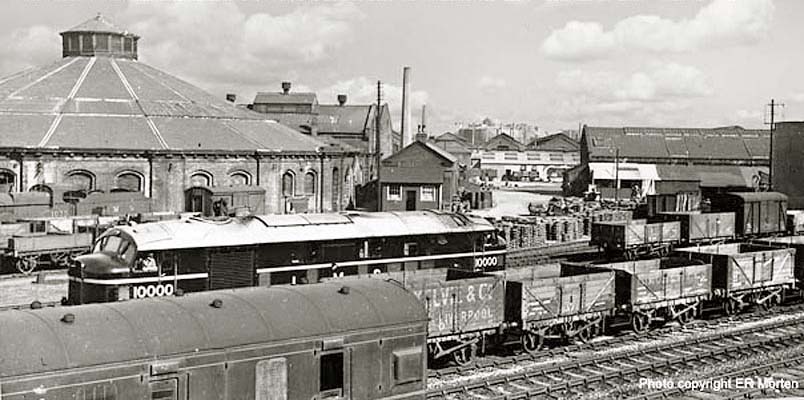
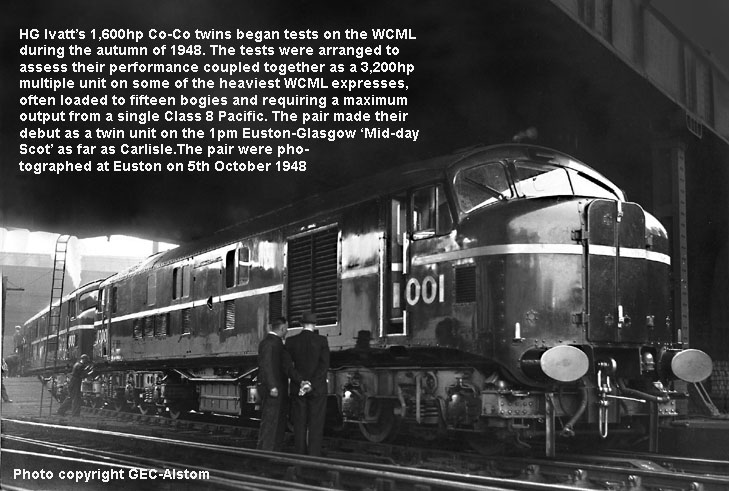
Alf Holland went on to tell me about one particular day as a young fireman when he was called upon to pair with his fiancé's father on an express turn from Derby to St Pancras. He was apprehensive at the prospect of working with his girlfriend's dad but equally keen to make a good impression. The loco was an elderly Midland Compound, a regular performer on the route, but by the 1950s the 4-4-0s (introduced to traffic in 1924) were getting a little long in the tooth.
Their journey was uneventful to begin with; Alf minded his P's & Q's and ensured he tackled everything absolutely spot on, but things were about to take a turn for the worse as he prepared to dip the scoop to pick up water from the troughs near Wellingborough.
Alf told me - 'I had just unscrewed the mechanism right down and then pulled it back a couple of turns to ensure we got just the right amount of water, but I was a trifle late in pulling it back and we hit the troughs with the scoop fully extended. The result was the tender overflowed with icy water, cascading a torrent of coal down into the cab and washing it right off the engine!'
The upshot was they reached St Pancras with a spotlessly-clean cab but barely a couple of shovelfuls of coal to keep the firebox at the required heat. It was a sobering lesson at such a young age.
A footnote to this story may give the young site visitor some idea of the way authoritarian-style conventions were often at odds back in the Fifties. Whilst the youthful Alf was considered old enough to fire a London express (not to mention the responsibility he had for the safety of hundreds of passengers) his fiancé's father still held him accountable for seeing his daughter was back home by ten every evening!
(Above-Below) Dipping the scoop to replenish the water at speed required a high degree of skill…here 'Black 5' No 44690 skims over Salwick Water Troughs between Preston and Kirkham on 3rd June 1963. (Below) 'Jubilee' class No 45647 Sturdee takes on more water than its 4,000 gallon tender capacity can cope with at Salwick Troughs on 23rd October 1966.
Characters abounded on the railways in times past, particularly those who drove and maintained Britain's grimy Goliaths; Alf told me on a couple of occasions of another fireman called Ginger, who, if bored when firing on a slow moving goods train, would literally step out of the cab and take a walk along the running plate to the front of the engine then around the smokebox before returning to the cab by the driver's side…all whilst the engine chuffed and chugged along! Goodness knows what his drivers thought about such behaviour, not to mention the goggle-eyed signalmen along the route.
Sadly neither Eddie Prince nor Alf Holland are with us as the 21st century rolls on, they have moved on to that great roundhouse in the sky, but their tales of the footplate and reminiscences will always be with me. Likewise whilst working at Derby's Rail Technical Centre I spent many happy hours chatting to Pete Skelton, an ex-Nottingham fireman. He joined the railways in the early Fifties, or as Pete succinctly puts it - 'They were so short of staff at loco sheds they gave you five bob if you signed up.'
Likewise whilst working at Derby's Rail Technical Centre I spent many happy hours chatting to Pete Skelton, an ex-Nottingham fireman. He joined the railways in the early Fifties, or as Pete succinctly puts it - 'They were so short of staff at loco sheds they gave you five bob if you signed up.'
Pete even enticed an old school mate out of a job as a butcher's boy to join him cleaning engines. It was not long before both of them acquired firing turns on expresses down the Great Central mainline at the tender age of 17. By the end of the decade he had switched to the clerical ranks, yet he never lost his affection for those he had toiled and sweated with. In his opinion 'They were real blokes…'
In his latter role as the supremo for the Rail Centre's cash office, he brightened the lives of many with his humour and tales from the footplate. If you were having a bad day, then a wander down to Pete's abode to collect your expenses always brightened the mood. As a queue formed for the two o'clock opening, Pete would sometimes greet the ensemble with - 'Crikey! You lot are impatient for your beer money today aren't you!' This he normally followed up with the first two verses of Gray's elegy or a literary gem of similar standing - if however the awaiting line was purely male, more than likely his opening gambit was a ditty that began with 'Whisky, women, cards and dice...'
Modesty forbids me from regaling the remainder.
Pete once took me over to see some of his old footplate pals: it was one of the most enjoyable evenings of my life. One old boy told me with pride how he began his railway career as a telegraph boy for the Great Northern Railway, but before they ever let him near an engine he had spent hours in a gloomy office, signing footplate-men on and off duty: the company issued him with half a pencil with strict instructions to make it last for he would not get another for three months.
Even during my early days with BR, such frugality was not uncommon.
One driver that Peter worked with was a frustrated mathematician and every time they stopped for signals he would get his chalk out and teach him advanced arithmetical techniques and trigonometry on the loco cab floor - perhaps his driver's impromptu maths lessons were the catalyst that prepared Pete for his future life as a cashier?
I remember clearly whilst as a young relief clerk spending a couple of days working with Pete on the warrant  travel section; he arrived at the office one morning in extra ebullient mood. On Nottingham station whilst switching from the Radcliffe train to the one for Derby, he had bumped into one of his old drivers who he had not seen for over two decades.
travel section; he arrived at the office one morning in extra ebullient mood. On Nottingham station whilst switching from the Radcliffe train to the one for Derby, he had bumped into one of his old drivers who he had not seen for over two decades.
'We did a little jig!' he exclaimed -'the entire gathering on the platform was staring at us! I remember one day we were on a return working from Rugby to Nottingham with a tank engine and he asked me how much water I thought we had left in the side tanks; he was speculating on whether we should replenish the tanks at the next water column - 'Let's test our skill,' he said, 'we'll be extra economical.'
Well, after passing three other columns at which we could have stopped to top up before reaching Victoria station, I was sweating cobs and continuously looking at the gauge waiting for the explosion that would take us all to Kingdom come. By the time we steamed back to Colwick sheds the tanks were bone dry!
When I asked why we had done it, he answered - 'Just to see if we could!'
(Above Left-Below) Team effort! Both driver and fireman replenish the side tanks of a BR Standard Class 4 tank at Woking. No fewer than 155 of these sturdy Class 4 2-6-4Ts were built between 1951 and 1956; 130 at Brighton, 10 at Doncaster and 15 at Derby Works. (Below) The Derby team was also responsible for constructing the bulk of the new BR Standard Class 5 4-6-0s. The first of the class, No 73000, was outshopped from Derby in April 1951 and the last No 73154 (one of thirty fitted with Caprotti valve gear and poppet valves) rolled off the production line in June 1957. This was the last steam locomotive to be built at Derby, thus bringing to an end a long and proud tradition at the Derby Works - a total of 2941 steam locomotives were constructed at Derby between 1851 and 1957.
Peter was one of many who relayed their stories with both unwavering loyalty and immense pride at the job they had once undertaken. Recently I was chatting to another old driver who had been a young fireman in wartime, often deputising on the footplate for many older colleagues pulled into the forces - 'Make no mistake,' he told me, 'The railways as much as anything won the war for Britain.'
Indeed it is difficult for many these days to comprehend the importance of Britain's railways before the motorway age, particularly in freight haulage. Nearby Toton in addition to Chaddesden sidings and Rowsley to the north once boasted gigantic marshalling yards. Even today Toton is of significance on the railway map; car drivers traversing the A52 can still witness a labyrinth of lines.
Returning when I can to Derby, I try to enjoy certain events as well as the company of friends; in addition to the annual summer beer festival, I love the model railway show in the Assembly rooms; undoubtedly, one of the best in the country. Older Derbians will recall Syd Sharratt's shop which stood on the long gone  Cockpit Hill opposite the bus station.
Cockpit Hill opposite the bus station.
When I arrived in Derbyshire at the start of my teens one of my first purchases was a model loco (Hornby Dublo Class 8F) from this very emporium, a wonderful vista for a thirteen year-old lad. Just recently, over four and a half decades later, my model engine needed its first overhaul. I forwarded it to master of models Bob Denny who formerly had a model shop on the corner opposite Long Eaton station (once known as Sawley Junction). Now an octogenarian, Bob has lost none of his skills and the 8F was returned in superb running condition. Here too is a local chap of immense railway lineage - both he and his father were footplate men at Toton before he too made the switch to work in the Railway offices at Derby's Nelson Street HQ. In Bob's case as a young man he worked on the Beyer Garratt's, the largest locos ever to take to Britain's tracks. These articulated steaming behemoths were built especially for the sole purpose of conveying coal from the Derby/Notts coal field to southern England. They consumed a vast amount of coal themselves as they hauled immensely long trains of black gold south. No doubt they were also taxing work for loco crews. Trains still snake out of Toton but the visual drama is not what it once was.
(Below) In 1927 the LMS recognised the need to provide a more powerful locomotive to take over the heavy Toton to Brent coal trains worked by double-headed 0-6-0s. Built by Beyer Peacock of Manchester, the 2-6-6-2 Beyer-Garratt provided a tractive effort of 45,620lb and was essentially two 2-6-0s with one large centrally-placed boiler common to both. Although the Beyer-Garratt was by far the biggest of the LMS locomotives (length 87ft 10½in) the distribution of the axle load conformed to the severe loading restrictions on the route. A further thirty were built with rotary coal bunkers in 1930, including No 47994 seen here at Toton shed.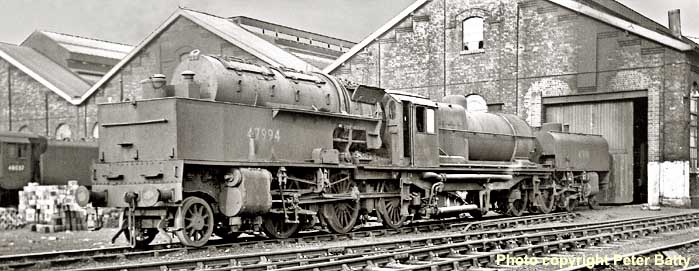
My only pal still driving is another Derby lad who I will refer to by his nickname 'Nooge'. A decade and half ago when I was still a Public Relations Officer, I was lucky enough to spend a working afternoon with Nooge on the past Denby branch; a true rural gem threading its way through Little Eaton and Coxbench.
Nooge, I shall state, is like the railmen of old and quite a character - in the olden days, drivers progressed from cleaning and firing - today a trainman concept is in place and many of the 21st century drivers were once guards, ticket collectors, shunters and other 'hands on' occupations.
In Nooge's case he did the lot before becoming a driver. One of his favourite tales is rather risqué but amusing. When still a young passenger guard, he was working on a late evening London-Derby train when he encountered a group of young women returning from the capital after a day out....all were worse for wear after more than a few drinks, and some had mislaid their tickets. One in particular could not find her travelling docket...
'You must have a ticket M'duck' said Nooge - 'Are you sure you can't find it?'
In a fit of giggles the girl in question raised her skirt significantly showing ample and shapely legs - 'Can't you take it out of that?' she cheekily suggested.
'I was hoping you'd have something smaller!' replied my pal.
During my entire life the connection with trains and humour has always been present. In the old Derby Works, folk often spoke of the 'Railway Sense of Humour'.
I like to think it is still alive and well!
(Below) We started this feature with the Derby-built LMS pioneer main line diesels Nos 10000/1, and so it seems appropriate to end with another diesel class that rolled off Derby's assembly line. In 1959 the BR works was responsible for building the BR/Sulzer 2,300hp 1Co-Co1 Nos D1-D10 as part of the British Transport Commission's (BTC's) pilot scheme orders. These orders were placed by the BTC in order to evaluate the performance of different types of diesels in service conditions. The ten Type 4 'Peak' locomotives were extremely heavy, turning the scale at more than 138 tons which necessitated the use of the cumbersome 1Co-Co1 wheel arrangement to help distribute their weight. The Peaks had the dubious distinction of being the heaviest, yet they had a neat appearance - the nose-end closely resembling that of Derby's earlier LMS pioneers No 10000/1. All ten locomotives (Class 44) were named after Welsh or English mountains, and the name 'Peaks' was subsequently dubbed on the production models. Here the doyen of the class, No D1 Scafell Pike, poses for the official photographer at Derby prior to entering service in September 1959.
Neil has a host of other tales to tell from the land of the railway press office and these will be added in due course; indeed I'm grateful to all contributors, for having started this railway website back in 2007 I have now reached a point where I've run out of things to say!
However, this isn't caused by 'writer's block'; it's a matter of pitching stories about trains and railways in a way that appeals to everyone. This is why I'm happy to invite other fellow enthusiasts to chip in with their own train spotting anecdotes for others to enjoy. Not only does it bring a freshness to these pages, the subject of trains and railways is so complicated it is impossible for one person to cover it on their own.
Over the years I've received a number of interesting emails from Hugh Peate, a technical advisor in the commercial boiler manufacturing industry who, after a bit of arm-twisting, agreed to write a short feature on LMSR matters…still under construction
LMSR AND OTHER RAILWAY MATTERS 1
By Hugh Peate
Hi David, you asked for an article on LMSR railway matters and so I've been browsing through your wonderful site again and here are a few items of interest to me. I have immense regard for both the GWR and  LNWR/LMSR traditions, in particular for all things Stanier, and for the way he developed the Swindon tradition forward through his work at Crewe.
LNWR/LMSR traditions, in particular for all things Stanier, and for the way he developed the Swindon tradition forward through his work at Crewe.
Having spent the best part of my childhood train spotting at Chester, I enjoyed visiting John Stoddart's page 72 which shows 46245 City of London (right) at Chester accompanied by a caption stating - '46245 appears to be passing non-stop through Chester General, possibly with up empty stock since I can recall very few passenger trains, apart from holiday camp specials for the coast, working non-stop through the station....'
As I believe it, the cylinder drain cocks are open, and that which issues forth is vapour, not steam, indicating that the cylinders are cold. I believe this loco is starting away from cold with what is clearly a very heavy train. It can't be going at any sort of speed, as the vapour is shooting ahead of the loco.
(Above) Awaiting caption details for 46254 at Chester by JR Carter…
(Below Left) 'Pride of the Line' was often a term used to describe the Princess Coronation class, designed under the guidance of Sir William Stanier. 46228 Duchess of Rutland was one of the glorious original streamlined engines, built with a single chimney, looking somewhat different in 1960, but just as powerful. The 4-6-2 is London-bound on platform  4, with another Stanier concept on platform 6; a 2-8-0 '8F' in charge of a freight. Passenger trains used to have to 'draw up' at stations en route, such as Bletchley, because they were much longer than the platforms. Am I alone in finding 'Bletchley' an exceedingly unattractive name? I suppose 'Milton Keynes' is a bit better, which is what that station is called now.
4, with another Stanier concept on platform 6; a 2-8-0 '8F' in charge of a freight. Passenger trains used to have to 'draw up' at stations en route, such as Bletchley, because they were much longer than the platforms. Am I alone in finding 'Bletchley' an exceedingly unattractive name? I suppose 'Milton Keynes' is a bit better, which is what that station is called now.
I suppose we all know what we like, by which we perhaps mean more truthfully that we like what we know. Be that as it may, these wonderful engines were to my mind the most powerful, elegant and dramatic heavy express steam locos we ever had in Great Britain. The biggest and best! It seems quite astonishing that the last survivors of the class were scrapped in September 1964 - only ten years before the West Coast Electrification was completed to Glasgow. Some were only sixteen years old and the other survivors were only about twenty, and could have worked for those ten more years.
I went to Primary School in Chester, and we had a day trip to London after sitting the 11 Plus. To my eternal regret, I did not note the number of the loco hauling our train back from Euston, but I like to think it was a Stanier Pacific. I do remember that the train was seventeen coaches, and that we had a dinner on the way back which included about five courses.
(Above-Below) This view of the Hoole Bridge end of Chester General station shows the arrival of the 'up' 'Welshman' behind EE Type 4 D223 Lancastria. This Euston-North Wales service had portions connecting with Portmadoc, Pwllheli and Llandudno. Click HERE to visit Chris Carter's page dedicated to the memory of his dad, Footplate Cameraman Jim Carter. (Below) Caption to follow for two photos taken minutes apart on 10 April 1952 - left 44864 - right 6860. This is a splendid example of a gantry carrying early-pattern Great Western lower quadrant signals; the most notable features of GWR signals were swan-neck spectacles, and the signal arms were constructed of enamelled steel, ribbed along the edges for rigidity.
We spent many hours spotting at the Hoole Bridge end of what was then called Chester General Station. 'General' was a name used for stations which were Joint Stations owned by the Great Western Railway in common with one or more other companies. I think, in fact, that this name only applied when the Joint Company was the London and North Western Railway, and only when there was another, less important Station in town. Wrexham is another place with a station formerly known as 'General'. The triangular junction to the west of Chester General connected to Birkenhead Woodside on the GW/LNW Joint line for Wirral and some Liverpool traffic, and in the other direction continued what looked like a four track railway. It cut twice through the Roman City Walls, dodging just within the Northwest corner. This part of Chester is fascinating in its transport history. The canal basin is there on the other side of the railway, all designed by Thomas Telford. There's a dry dock, warehouses, a sea lock down to the River Dee and the Northgate flight of locks. The roof of the lock-keeper's house almost touches the elevated inner Ring road, built in 1966. The railway runs by, and all is overlooked from the Roman walls.
The four lines continue over a viaduct between the Roodee (Chester Racecourse, and the site of the Roman harbour) and former gasworks, and then over the River Dee. This bridge is the location of one of the earliest railway disasters, when the original cast iron bridge collapsed under a train. The engine got across safely,  and the driver, with great courage and presence of mind, crossed to the other line and drove back over the other, still standing bridge, identical to the one which had just collapsed, to report the accident. There were no telephones or telegraphs in those early days. Over the river, the apparent nature of the four tracks is revealed, as the two southern pairs of rails are the GW line to Wrexham, Shrewsbury, Wolverhampton and further away, and the northern pair are the LNW line, following the North Wales coast, across the Menai Straits and Anglesey to Holyhead for the Irish traffic. How the Great Western would have loved to have that traffic! There were several LMSR/GWR Joint lines in our home area between Chester, Helsby and the Wirral. The LNWR/LMS and GWR may have been deadly rivals, but what railways they were! Both companies paid good, and frequently, excellent, dividends to their owners throughout their existences, right to the end - unlike two other railways I could mention!
and the driver, with great courage and presence of mind, crossed to the other line and drove back over the other, still standing bridge, identical to the one which had just collapsed, to report the accident. There were no telephones or telegraphs in those early days. Over the river, the apparent nature of the four tracks is revealed, as the two southern pairs of rails are the GW line to Wrexham, Shrewsbury, Wolverhampton and further away, and the northern pair are the LNW line, following the North Wales coast, across the Menai Straits and Anglesey to Holyhead for the Irish traffic. How the Great Western would have loved to have that traffic! There were several LMSR/GWR Joint lines in our home area between Chester, Helsby and the Wirral. The LNWR/LMS and GWR may have been deadly rivals, but what railways they were! Both companies paid good, and frequently, excellent, dividends to their owners throughout their existences, right to the end - unlike two other railways I could mention!
(Above-right and Below) Caption pending for for the Roodee Bridge shots…WR unknown Hall class date 10 April.1952…(Below) Class 8F 48290 on same day…both ER Morten
Chester's other station was Northgate, situated across the Shropshire Union Canal (in a very deep sandstone cutting) from the Northgate in the city's Roman walls. This was the Chester terminus of the Cheshire Lines Committee Railway, a Joint railway company, whose route mileage was mainly in [what was then] Lancashire. Chester Northgate, like the western end of General, also opened out onto a triangular junction, with lines going to Connah's Quay in North Wales in one direction, and to Manchester Central, via many stations serving small villages plus the towns of Knutsford and Northwich in the other.
This line crossed the GWR/LNWR Joint line from Chester to Manchester via Helsby, Frodsham and Warrington soon after leaving Chester, at Mickle Trafford. There was a sharp S bend where the later CLC line crossed over the older route, and the two lines kissed and parted. There are two underbridges of very different designs, one an arch, the other, girders. The connecting pointwork, removed in 1875, was reinstated in 1968, and the track west to Northgate lifted, since when all trains go into General over the older route. Nothing is left of Northgate Station or the CLC in Chester, save earthworks.
The other terminus of this line and of many other CLC routes was Manchester Central, another Joint Station, principally owned by the Midland Railway. This too, closed in about 1969, became a car park for a while, and is now famous as an exhibition centre. This Cheshire Lines railway from Chester Northgate to Manchester Central always seemed an oddity. This was because, fifteen and more years after Nationalisation, it was powered by Eastern Region locos, in a faint but surely economically ludicrous echo of its former Status as a Joint Railway.
My other memory of such interlopers is of a steam-hauled day trip from Brackley to London Marylebone and back in the early Sixties, on the greatest of all former Joint Railways, the Great Central. There seemed to be much slipping and clanking - aka the 'Gresley ring' - going on! Neither to be seen or heard in the West, or any of the nearby LMS or GW lines. There probably wasn't much in the way of enthusiasm for the job, as the line closed not long after. This Joint Railway was the fruit of the union between the Manchester, Sheffield and Lincolnshire Railway, doing its damnedest to get into London, and the Metropolitan, busting a gut to get out! The M S & L ('Money Sunk & Lost') and partners formed the G C ('Gone Completely') which never did pay any dividends, and was a drain on its successor, the LNER. The tragedy of the closure of this superb, beautifully engineered line, built to the Berne or European loading gauge is, I suppose, matched only by the irony that there are now battles going on to reinstate it in the form of HS2 - barely two generations later!
(Below) This is the splendid view from the footbridge spanning the platforms at the north end of Crewe station; the Manchester line is to the right, the Liverpool and WCML route to the North in the centre, and the Chester lines are on the left. Crewe North Junction signalbox is prominent in the centre and part of the Works is visible behind it on the horizon left. Stanier 'Coronation' 8P 4-6-2 No. 46236 City of Bradford approaches Crewe in 1957 with the 10.15 Manchester London Road to Bournemouth West 'Pines Express'. The mobile gas-cylinders are probably for replenishing the reservoirs on kitchen-cars. Click HERE to visit the geograph.org.uk webpage.
I regret that I lost my Ian Allen 1963 'combo' many years ago, and the only spotting record I now have is in a Woolworth's Winfield notebook of a day at Crewe 51 years ago. (Winfield was what the W in F W Woolworth stood for. Little did I think then that Woolworths. along with almost all of these engines, would be history). Here is the list copied from my notebook:
Crewe Sunday 10 March 1963
North end of station.
This trip may have also included a visit to Crewe Works, I can't remember.
I've inserted a '?' after any which are not clear; I think the rest are correct...
42583 46144 47297 5995? 46155 73067 43525 E3078 E3097 E3081 E3071 E3016 E3076 E3002 E3079 45046 47310 [could be 47380] 84022 43977 42380 47959 48748 45250 45426 45353 D338 46162 70018 E3031 E3052 E3088 E3062 E3022 M50471 M59179 M50523 45250 48748 E3019 47505 45669 E3055 D336 46162 D209 D329 D322 46248 46253 45251 45446 61384? 45567 46243 78030 71000 44081 70050 70054 44759 44681 46063 D227 45444 49448 4907? 45721 46254 70052 41212 D858 D819 D297 D311 45353 71000 44681 45556 46243 46238 45567 44680 45270 46157 5426? 44352 46243 47618 43959 47658 44373 47380 D57 77661 46154 46159 D1056-73 [Westerns under construction in the Works?] D340 D300 D266 D224 D235 46203 D369 D581 D330 45726 42065 92076 92092 40512 70051 98108 92108 92043 92231 4831? 92163 48358 92211 48275 48246 92087 45040 45422? 92044 44088 45580 45004 78019 92007 82044 D215 D292 D223 D326 D221 D303 45325 45093 43187 44730? 48511 45387 92004 44848 44781 92231 45040 45154 45441 45247 92009 48037 92076 92069 46203 D381 45560 48414 49106 45318 48174…
46465 (this looks as if it might be 46265, which did not exist, perhaps 46256 Sir William A Stanier FRS? - wishful thinking is all this can be now!) 86136 (I guess this should be 80136?) 48002 48438 48417? 43275 42189 45102 45200 45550? 46230 45275 D370 D341 48388 D299 46424 D296 D318 92220 49395 1057 44894 45349 45297 46880?-46080? 46238 46236 47618 46495 D221 D233 D375 D325 D333 44683 42959 3876 [?- 43876?] 46035 48444 44450 92097 45656 46486 45409 45474 90714 78031 78055 70047 47677 47354 78031 47330 43034 45000 47615 45067 70023 70037 47482 45634 42965 92077 45005 48309 42984 45000 47406 48516 47467 47354 47677 47384 75057 78055 45000 47648 47450 45420 45158 43418 45392? 70007 44834 44688? 70007 70037 70027.
(Hugh Peate's article continues further down the page)
FOOTNOTE. I've have received an email from contributor Phil James, who has two articles - 'The Quest for Cops 1-2' - featured on the 'Train Spotting-2' HERE.
Phil writes…'David, I have been working my way through your site and came across an article by Hugh Peate featuring list of engines seen at Crewe on March 10th 1963 (above). In the early 1960s, the West Coast Main Line between Rugby and Crewe was my hunting ground, but I could spend a whole day there and hardly `cop` anything. The main hope was that a Scottish-based engine might have managed to avoid being taken of its train at Carlisle or that an interesting `foreigner` might be on its way to or from Crewe Works.
Hugh lists 46230 Duchess of Buccleuch as seen that day. This was my last 'Duchess' and to see it I had to visit 66A Polmadie in April 1963 when it was tucked away in the confines of the shed, in store I believe, along with most of the other 66A Duchesses. If it was at Crewe in March, this must have been one of its last workings. Also at Crewe that day were 'Britannias' 70037 Hereward the Wake and 70007 Coeur-de-Lion. I am not an expert, but I was under the impression that the Eastern Brits went to Doncaster for overhauls. Why were they there 9 months or so before they were transferred to Carlisle? No doubt someone with far more knowledge than me can provide an answer. 70037 was the only Brit that managed to avoid me despite two trips to Carlisle and being allowed around Kingmoor on both occasions, courtesy of a kind foreman.
I have saved the best to last. Also listed that day were 'Black 5s' Nos 45154 Lanarkshire Yeomanry and 45158 Glasgow Yeomanry. Along with 45157, these named Scottish based Stanier 5s were incredibly rare to all of us who lived south of the border. On two shed bashes to Scotland I only managed to see 45158, but did not realise until later. I had not slept for a long time and I think I was on auto-pilot by the time I went round Eastfield. Amazingly, to me at least, Hugh Peate does not mention any of the above engines as the interesting ones seen. If I had been at Crewe that day in March 19 63 I would have gone home with a huge smile on my face which would probably have taken a week to disappear. I suppose it was all about being in the right place at the right time. Regards, Phil James...'
In response to Phil's query regarding the Eastern Region 'Britannias' Nos 70007 and 70037, there is an interesting in-depth study of all the BR Standard Class 7MTs Nos 70000-70054 by Derek Dean on Pages 90-92 HERE.
Derek adds...'The fate of the 'Britannia' Pacifics was in the balance during 1963, but the plain fact of the matter is that the engines were a little over 10/11 years old at the time which saved them from complete annihilation, although this was little more than a stay of 'execution'.  No Britannias were recorded as entering Doncaster Works beyond late 1962, all being maintained at Crewe thereafter, while nine class members were stored at March depot (31B) for the best part of 1963. No 70007 Coeur-de-Lion was a fixture at Crewe for interminable chassis frame repairs (cylinder mounting brackets) and No 70037 Hereward the Wake had been serviced at Crewe and was most likely stored there pending their collective future employment.
No Britannias were recorded as entering Doncaster Works beyond late 1962, all being maintained at Crewe thereafter, while nine class members were stored at March depot (31B) for the best part of 1963. No 70007 Coeur-de-Lion was a fixture at Crewe for interminable chassis frame repairs (cylinder mounting brackets) and No 70037 Hereward the Wake had been serviced at Crewe and was most likely stored there pending their collective future employment.
(Inset right) A sorrowful 'Britannia' No 70007 Coeur-de-Lion awaits the 'off' with a northbound express from Lancaster (Castle) Station in July 1964. No 70007 was the first of the class to be withdrawn on 19th June 1965, and the only Britannia to be taken out of service from Crewe Works. The engine was stored at Crewe South depot for a short time before being cut up at the Works in July 1965.
LMSR AND OTHER RAILWAY MATTERS 2
by Hugh Peate
Steam, diesel and electric locos! During my visit to Crewe in 1963 the really surprising one was 71000 Duke of Gloucester, which I jotted down several times. I think he must have been working that day, as it seems unlikely that we would have logged a static loco more than once, although he was said to be stored out of use by this time. Maybe we saw him twice in the Works? How I wish I had a clear memory of it! I was very surprised to see 71000 again at Barry about ten years later, and was convinced by the state he was in then, that he would never steam again, like the two Kings 6023 and 6024 seen there. These three are all preserved in working order. We saw and cabbed a King, 6012, I think, at Shrewsbury, which must have been in 1962, the last year they ran on BR. I saw 6024 working there again 45 years later. Other notable engines from that Crewe day include 92220, 45000 and 46203 - Princess Margaret Rose.
(Above-Below) Designed at Derby and built at Crewe Works in May 1954, the unique Class 8 Pacific 71000 Duke of Gloucester was intended to represent the pinnacle of modern British locomotive development, but No 71000 was unpopular with crews for being a shy steamer and after only a short working life based at Crewe North MPD the locomotive was withdrawn from traffic in November 1962 and languished at Crewe for a long period pending a decision on its future. Following the removal of the loco's outside cylinders for display at the Science Museum London, a bizarre mix up resulted in the condemned 71000 being sent initially to the wrong scrapyard at Cashmore's in Newport instead of Woodham Bros in Barry. Had it stayed at Cashmore's there is no doubt that it would not have survived, but in the event it ended up at Woodham Brothers where its rescue led to one of the most remarkable restorations in the preservation movements. The dilapidated No 71000 was photographed at Barry on 13 August 1966
Below) Rail Cameraman Keith Long certainly has an eye for a good shot. Not content with the usual three-quarter angle, he chose a viewpoint from the turntable pit at Carnforth shed to photograph two 'Princess Royal' class locomotives in store: 46203 Princess Margaret Rose, the first of the modified design, withdrawn in October 1962 but now preserved - along with the first of the original design, 46200 Princess Royal, withdrawn in November 1962 and scrapped at Connell Union Works, Coatbridge in October 1964. Click HERE to visit Keith's page; links are provided to his 'Cabsaab900' flickr site, well worth a visit.
Inset left & inset right) An interesting shot of newly-built 'Royal Scot' class No 6115 in its original LMSR form with parallel boiler. Constructed in 1927 by the North British Locomotive Company in Glasgow, No 6115 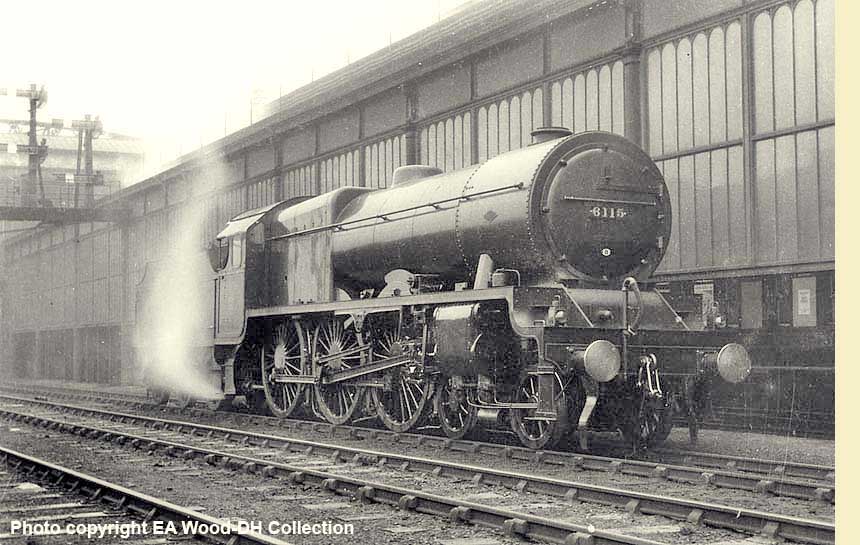 was later named Scots Guardsman. A Longsight engine for most of its life the now-preserved 6115 was the last of the class to be rebuilt with a new tapered type 2A boiler by the LMSR in 1947. (Inset Right) In 1933 the LMS was invited to send a locomotive and train to the 'Century of Progress' exhibition in Chicago USA. It was decided to send a 'Royal Scot' class and the locomotive selected to assume the identity of the doyen of the class, No 6100, is generally regarded as being No 6152 The King's Dragoon Guardsman, which was due a general overhaul at that time. On its return from the USA, the locomotive was fitted with an enlarged nameplate with details of its appearance at the exhibition. This is a close up of the nameplate and commemorative plaque, including the name of the driver, fireman and fitter who accompanied the locomotive on its visit to the Chicago World Fair and tour of the USA and Canada. The photo was taken by Keith Long…click HERE to visit Keth's fantastic 'Cabsaab900' flickr photostream
was later named Scots Guardsman. A Longsight engine for most of its life the now-preserved 6115 was the last of the class to be rebuilt with a new tapered type 2A boiler by the LMSR in 1947. (Inset Right) In 1933 the LMS was invited to send a locomotive and train to the 'Century of Progress' exhibition in Chicago USA. It was decided to send a 'Royal Scot' class and the locomotive selected to assume the identity of the doyen of the class, No 6100, is generally regarded as being No 6152 The King's Dragoon Guardsman, which was due a general overhaul at that time. On its return from the USA, the locomotive was fitted with an enlarged nameplate with details of its appearance at the exhibition. This is a close up of the nameplate and commemorative plaque, including the name of the driver, fireman and fitter who accompanied the locomotive on its visit to the Chicago World Fair and tour of the USA and Canada. The photo was taken by Keith Long…click HERE to visit Keth's fantastic 'Cabsaab900' flickr photostream David, on the Crewe page 8 and LMR-1 page 27, you write - 'Prior to accelerating the Anglo-Scottish expresses on the West Coast in 1927, the LMS took the unusual step of borrowing a 'Castle' class 4-6-0 from the GWR for tests between Euston and Carlisle. The performance of the GWR engine proved superior to the LMSR's 'Claughtons', so a decision was taken to dispense with Sir Henry Fowler's planned 3-cylinder compound and 4-cylinder compound Pacifics, and an order was placed with the North British Locomotive Company of Glasgow to build fifty 3-cylinder 4-6-0s with a parallel boiler and Belpaire firebox…'
David, on the Crewe page 8 and LMR-1 page 27, you write - 'Prior to accelerating the Anglo-Scottish expresses on the West Coast in 1927, the LMS took the unusual step of borrowing a 'Castle' class 4-6-0 from the GWR for tests between Euston and Carlisle. The performance of the GWR engine proved superior to the LMSR's 'Claughtons', so a decision was taken to dispense with Sir Henry Fowler's planned 3-cylinder compound and 4-cylinder compound Pacifics, and an order was placed with the North British Locomotive Company of Glasgow to build fifty 3-cylinder 4-6-0s with a parallel boiler and Belpaire firebox…'
This is a very vexed question. After the Grouping, the former Lancashire & Yorkshire Railway and former Midland Railway factions both wanted to prove their locomotives superior to those of the London & North Western Railway on the West Coast Main Line. The L&Y 4-6-0s were shown to be inadequate, and the Midland's biggest superheated locos, the Compounds, were only 4-4-0s - and there were only about 26 of them! Nevertheless, the Midland faction was in the ascendancy, and they wanted at first to show that their two dozen little engines could do the job! The 535 superheater locos from the LNWR were hauling the most intensive and heaviest - and most remunerative - traffic in Europe, and the LNWR had been known for decades as the 'Premier Line'. The Claughtons had produced impressive test results in 1913, and they were doing work greater than anything performed on the GWR. CJ Bowen-Cooke, the Chief Mechanical Engineer of the LNWR, had died tragically in 1920, and he had stated that he was 'going to take the Claughtons in hand'. They were being fitted with improved piston valve heads and various other modifications. It would be so interesting to know how these and other subsequent Crewe locos would have developed in the LMS era, given different management from the top. For instance, would the Pacifics have emerged with four cylinders in line driving the leading coupled axle, resulting in zero hammer-blow, like the Claughtons?
Zero hammer-blow means that the reciprocating parts are fully balanced, and there are no violent up-and-down forces on the track. The Claughtons were the only locos without nett out of balance forces. Anyhow, the realisation came that a few Compounds could not do the job. Railway politics reared their head (don't they always?) and a GWR Castle ran on trial on the Premier Line. It is a long story, resulting, via the scrapping of advanced work on another new design, in the Royal Scot class of locos, and the gradual dawning of a new era.
The real tragedy of the LMS was that it took ten years for the constituent Company factions to get into bed together amicably and work to the same end. Even so, there was much duplication of effort. For instance, the Royal Scots and the Patriots were very similar, the Scots being a new design, and the Pats were in fact 'accountant's rebuilds' of the Claughtons, meaning that they were really all-new engines - Derby had to have its go.
William Stanier arrived at the LMS at the end of those ten awful years. His brief was to start a drastic policy of scrap-and-build. This programme of work was almost complete when WW2 broke out, so there were just a few older locos surviving right through to BR days. Stanier's first express passenger locos, the Jubilees, were pretty much the same power as the Scots and Pats, and the three classes became very similar after various stages of rebuilding. Stanier also produced the legendary Class Five mixed traffic engines, known also as 'Black Fives' or 'Mickies, and the equally legendary 8F freight engines. And then the two series of Pacifics. William A Stanier was knighted and became an FRS. The penultimate Pacific was named after him - long after he retired. A truly great and modest man.
(Above-Below) A nameplate, measuring 75¾" long, the original paintwork touched up in places, went under the hammer for £20,000 at a Great Central Railwayana Auction in September 2015. Built at Crewe in 1944, the LMS Class 8P Princess Coronation 4-6-2 No 6250, later BR 46250, was formally named at a ceremony at Lichfield Trent Valley station by the Mayor of the Midlands city, Miss Agnes M Thompson, on 20 June 1944. (Below) This photo above shows the naming ceremony. Allocated new to Crewe North on 20 May 1944, 46250's later sheds included Polmadie, Camden and Upperby from where it was withdrawn during the week ending 12 September 1964 and sold for scrap to West of Scotland Shipbreaking at Troon. The engine was originally painted in the LMSR's black livery adopted by the company during the Second World War; this austere livery reduced the need for cleaning at a time of severe labour shortages. Click HERE to visit the National Railway Museum and SSP's 'Euston Photos' Collection. 
Also on the Crewe page you have captioned a Jim Carter photo of 46238 City of Carlisle as follows - 'Although officially designated the 'Princess Coronation' class, the Stanier Class 8P Pacifics will always be called the 'Duchesses'. It seems an odd choice, seeing that of the 38 members of the class, only 10 - Nos 6225-6234 - were named after Duchesses. The remaining locos carried a proliferation of 'City' names, except for No 6257 Sir William Stanier FRS, named in honour of the LMSR's CME 1932-1944 at a ceremony held at Euston in December 1947...'Well David, another Stanier Pacific was named after a man - 46244 King George VI, and one was named after his Mother, 46222 Queen Mary. Locomotives have been named since Richard Trevithick's 'Catch-me-who-can' in 1808.
(Below) A locomotive nameplate 'City of Chester' as carried by the LMSR's 'Princess Coronation' class Pacific No 6239. Built at Crewe in September 1939 to Lot 150, the loco emerged from the works with a double chimney, streamlined casing and painted in red and gold livery. A year after the streamlined casing was removed the loco became 46239 upon nationalisation in. A long time allocation to Camden (1B) the loco moved to Willesden (1A) for a short time and finally Crewe North (5A) from where she was withdrawn in September 1964. The loco was broken up at Cashmores, Great Bridge in December 1964. The cast brass plate measuring 75" x 7½" is one of the original plates fitted when the locomotive was built in its streamlined form and originally bore chromed letters. BR took most of the chrome away, but this example has retained it around the edges. The back has a 2" wide cut away section which slotted into the streamline banding. The nameplate went under the hammer for £28,000 at a Sheffield Railwayana Auction in December 2008. Click HERE to visit the company's fascinating site.
West coast loco naming and numbering is ever fascinating. The first run of the City series were named and numbered in alphabetic and numeric order. There was then a three year break in production, in the middle of World War Two, and the alphabetical sequence was lost. When production resumed in 1943, it seems that Hereford was left out and added in later, and Salford came later still, after that place became a City, and in BR days - a nice touch. Hereford was the only City name used which was on a Joint line, not exclusively LMS territory. Bradford, Leeds, Leicester and Nottingham were on ex-Midland Railway routes normally barred to the Pacifics, although it is said that these locos all went to their namesakes for the nameplates to be unveiled. Just reading the names applied to the Patriots, Jubilees and Scots - and four Black Fives - is an enlightening exercise in itself.
Many of the names were recycled from Victorian times, and they include islands, colonies, regiments, poets, authors, statesmen, nurses, sailors, and soldiers, including distinguished holders of the VC.
There is a wonderful tale, dating from late Victorian days. Her Majesty's Comptroller was one Sir Charles Cust, known to be of an irascible and perfectionist turn of mind. The Royal Train was heading north overnight, and stopped at Crewe to change engines; it was always double-headed. The new pair had just backed onto the train, coupled up, and the brakes were being tested. Sir Charles strode up, and was delighted to see that the train engine was none other than 'Sir Charles Cust'. On he went to look at the pilot engine - named 'Vindictive'! For all its faults, and they were many, the LMS was the largest shareholder owned Company in the World at the time, and it paid good dividends to those shareholders - right to the end. I write this as a diehard fan of both the LNWR/LMS and of the GWR - which seems to make me very peculiar!
Finally, I do like geographical conundrums. Which of the Grouping era Companies had stations the furthest North, South, East and West? The answers are: LMS Thurso in the north; GWR Helston in the south; LNER Lowestoft in the east - and, very surprisingly, LNER Arisaig - the penultimate station on the line to Mallaig - which is a fraction of a degree further West than Penzance, Stranraer, Oban, and the Kyle of Lochalsh.
(Below) Sporting a 28C Carstairs shedplate on the smokebox door, Fairburn 2-6-4T No 42173 awaits departure at Glasgow Central - superbly cleaned for the job. This is sporting the Caledonian rosette around the smokebox door handles and a 'Caley' semaphore route indicator. Lovely touches both, showing the pride of the shed and locomen, well into BR days.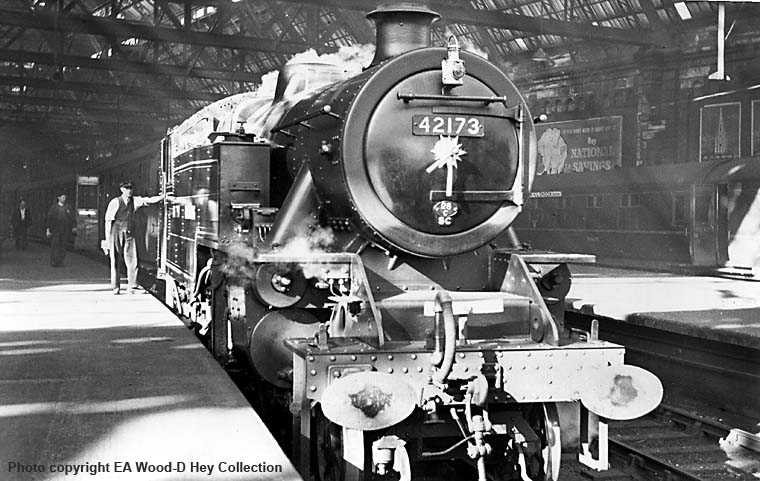
ALL CHANGE AT STAFFORD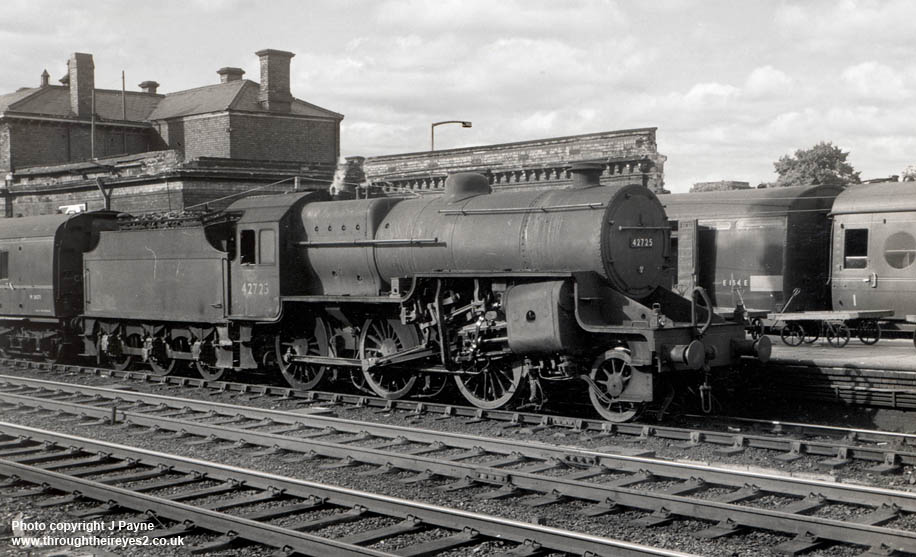
Above-Below) Stafford railway station lies at the junction of the Trent Valley Line and the Rugby-Birmingham-Stafford Line on the West Coast Main Line. The first station was built by the Grand Junction Railway and opened in July 1837. This was replaced by a second station in 1844, followed by a third and more grandiose architectural style in 1862, but this was swept away by the present station which was built as part of the modernisation programme when the West Coast Main Line was electrified in 1962. Here Hughes 'Crab' 2-6-0 No 42723 at Stafford in 1960. (Below) With evidence of modernisation well underway - part of the platform canopy and support columns have been removed, and a poster showing electrification progress occupies the wall of the Ladies Room - a couple of spotters cast quizzical looks from behind 'Patriot' class 4-6-0 No 45528 REME at the head of an 'up' train. Built in April 1933, this former paralleled boilered 'Patriot' (Baby Scot) suffered the ignominy of remaining nameless for 26 years! Rebuilt in September 1948, it wasn't until September 1959 that No 45528 was named REME after the Corps of Royal Electrical and Mechanical Engineers. The loco was among five members of the class withdrawn in1963; it was cut up at Crewe Works in April of that year. 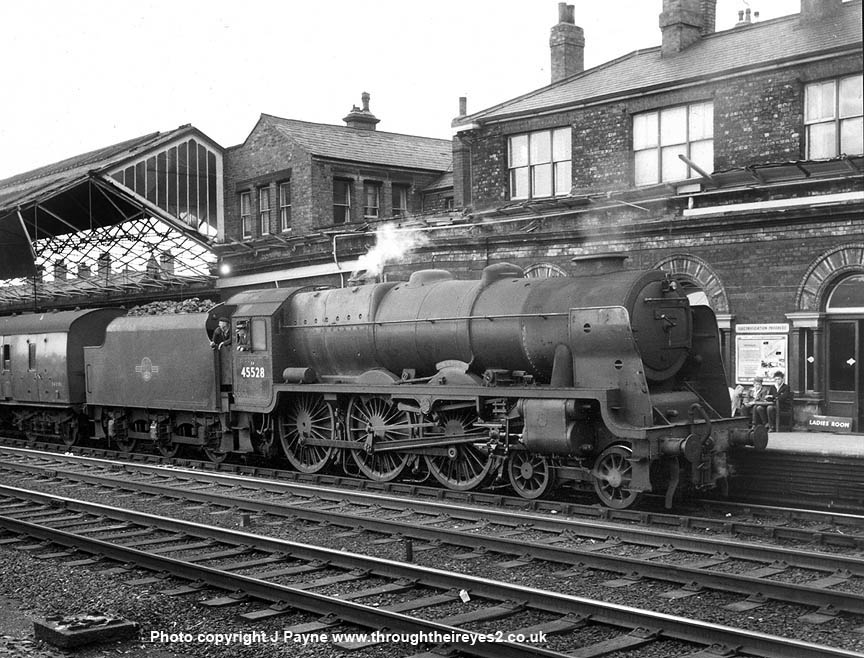
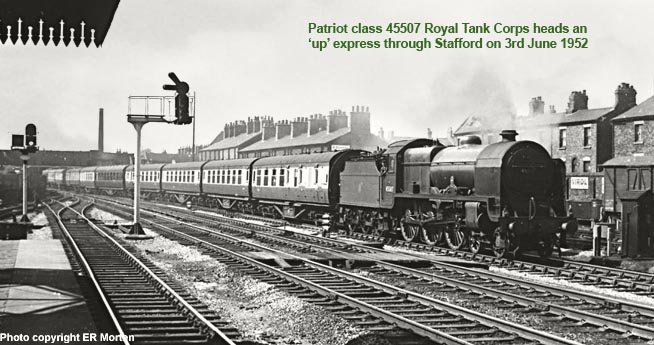

(Above-Below) Ivan Whitehouse, who was a fireman on the Midland Bushbury Shed (3B) from 1957 to 1963, took these shots of Stafford station on a 'borrowed' camera in 1958. The first one shows Rebuilt 'Royal Scot' class No 46129 The Scottish Horse awaiting departure with a northbound train. (Below) 'Jubilee' class 4-6-0 No 45586 Mysore is standing in the south bay on platform 1. 

(Above-Below) Missing its smokebox numberplate, Class 3F 0-6-0T No 47475 looks oddly antiquated whilst on station pilot duty at Stafford in 1958. An unusual feature of the 'Jinty' 0-6-0T was the position of the sandboxes; access was gained via a recess in the tank sides so that they could be filled. This shot by Ivan Whitehouse reminds me of my childhood days when Tri-ang produced a 00 gauge model of the Class 3F in the 1960s. Now am I the only one who assumed it was a clockwork model, that the hole in the side  was for the key? Just one question...where does the word 'Jinty' come from? (Below) Whilst on the subject of nicknames for locos, how long will it be before the colloquial use of the term 'Black 5' is construed as racially offensive? This is not as daft as it may sound. The irony of today's barmy PC world can be judged by a recent court case involving two Premiership players and an alleged racist remark during a game. Now I'm not about to go into the ins-and outs of it here; what I will say is that when the media covered the day's evidence in court - the one word deemed offensive enough to warrant a court case was the only one that did not require censorship…the rest (swear words) were obliterated in a blizzard of asterisks…the offensive word, of course, was 'black'…it's a crazy world. Here 'Stanier 'Black 5' No 44949 pilots 'Britannia' class 7MT No 70046 Anzac on a 'down' express through Stafford in 1960. (Inset above) A nameplate from the BR Standard Britannia Class 4-6-2 No 70046 Anzac went under the hammer for £8,000 at a great Central Railwayana Auction in April 2011. Built at Crewe and named in September 1959, No 70046 was allocated new to Holyhead in July 1954 and later Crewe North, Longsight, Willesden, Aston, then back to Holyhead again, before being transferred to Banbury and finally Carlisle Upperby from where it was withdrawn during the first week of July 1967. It was sold to Campbells, Airdrie on 3 October 1967. The loco takes its name from the Australian and New Zealand Army Corps formed during WW1.
was for the key? Just one question...where does the word 'Jinty' come from? (Below) Whilst on the subject of nicknames for locos, how long will it be before the colloquial use of the term 'Black 5' is construed as racially offensive? This is not as daft as it may sound. The irony of today's barmy PC world can be judged by a recent court case involving two Premiership players and an alleged racist remark during a game. Now I'm not about to go into the ins-and outs of it here; what I will say is that when the media covered the day's evidence in court - the one word deemed offensive enough to warrant a court case was the only one that did not require censorship…the rest (swear words) were obliterated in a blizzard of asterisks…the offensive word, of course, was 'black'…it's a crazy world. Here 'Stanier 'Black 5' No 44949 pilots 'Britannia' class 7MT No 70046 Anzac on a 'down' express through Stafford in 1960. (Inset above) A nameplate from the BR Standard Britannia Class 4-6-2 No 70046 Anzac went under the hammer for £8,000 at a great Central Railwayana Auction in April 2011. Built at Crewe and named in September 1959, No 70046 was allocated new to Holyhead in July 1954 and later Crewe North, Longsight, Willesden, Aston, then back to Holyhead again, before being transferred to Banbury and finally Carlisle Upperby from where it was withdrawn during the first week of July 1967. It was sold to Campbells, Airdrie on 3 October 1967. The loco takes its name from the Australian and New Zealand Army Corps formed during WW1. 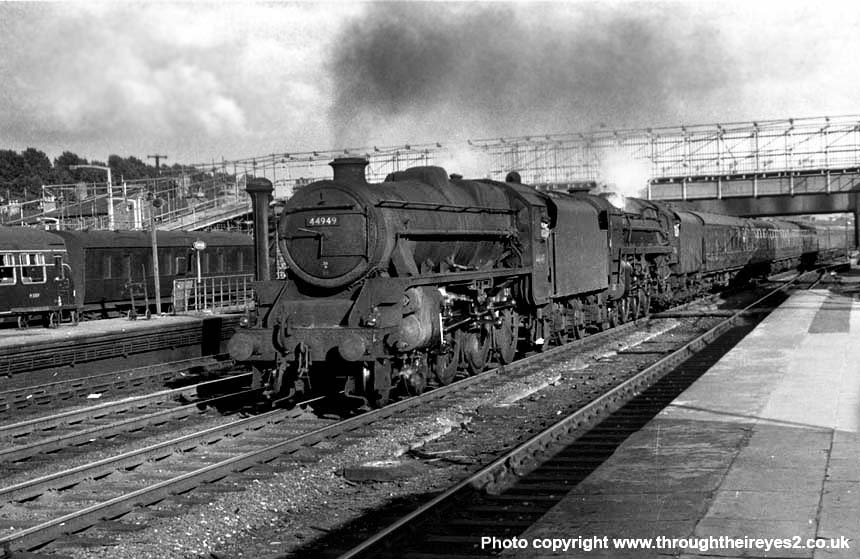
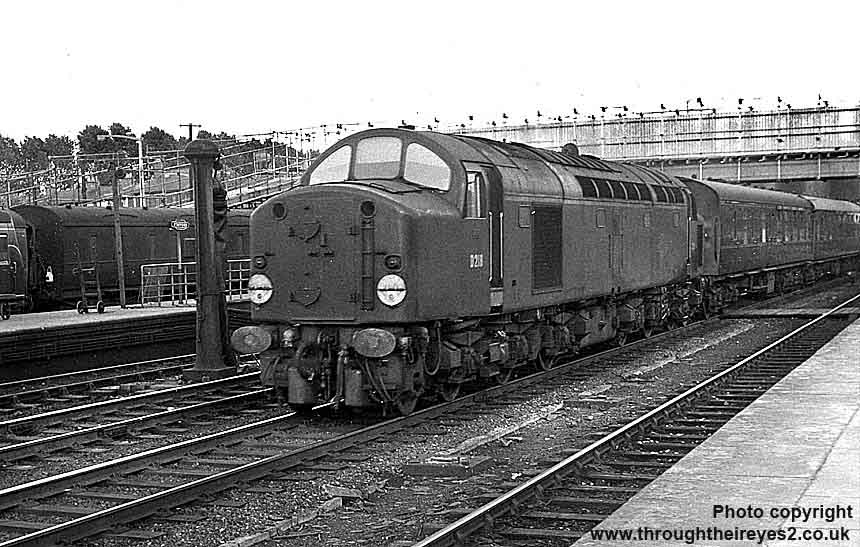
(Above-Below) For many years the West Coast Main Line had to operate under the baleful influence of modernisation. The nature of engineering work required for the installation of electrification masts included the lifting of road bridges, or lowering of track level to obtain the neccessary clearance for the overhead catenary. The WCML from Euston to Crewe required work on 78% of the 904 bridges concerned, whilst on the 44 mile between Crewe and Manchester, 82% of the bridges had to be rebuilt. Inevitably, the phase of modernisation involved prolonged disruption of train services. The bridge clearance work involved can be gleaned from this shot of EE Co Type 4 No D218 - later to be named Carmania in July 1961 - heading through Stafford in 1960. The EE locomotives Nos D210-D235 were named after ships operated by the companies Cunard Line, Elder Dempster Lines, and Canadian Pacific Steamships, which were associated with sailings to the port of Liverpool. (Below) The stunning images from the NMSI collection show the quality of poster art to be seen on station platforms across the country during the 1950-60s. For the record, the NMSI family is comprised of four award-winning museums, each with their own diverse identity: the Science Museum, the National Media Museum and, of course, the National Railway Museum (NRM) at York which houses the world's pre-eminent railway collection. Spread across three halls, the Great Hall - formerly the steam engine shed (50A) - is complete with a working turntable, while the Station Hall (previously York's central goods depot) is now laid out like a 'period' railway station. However, the NMSI's full collection is so big that only 8% of the artefacts are on public view. The rest are hidden-away just off the M4, on an ex-WW2 airfield. The Science Museum Swindon is a massive site housing collections ranging from the iconic Lockheed Constellation airliner to super computers, bicycles and the last Fleet Street printing press. The NMSI Collections Online is a superb website which displays countless thousands of objects including a range of fabulous railway travel posters...a visit is highly recommended. This British Railways (London Midland Region) poster - 'London Midland Electrification' was painted by John Greene in 1963 and depicts an AL1 class (later known as Class 81) locomotive with a passenger train in the new Stafford station. An electric multiple unit is waiting at an adjacent platform. The text beneath reads - 'Manchester, Liverpool, Crewe, Birmingham, London, still making good progress'
(Below) A mention must be made of the LMS-Patriot Project's praiseworthy aim to build a new 'Patriot' class steam locomotive to be completed in time for the 100th Anniversary of the Armistice in 2018. The new engine will be named 'The Unknown Warrior' upholding the tradition of former railway companies (in this case, the LNWR and LMS) who bestowed war memorial names on engines to commemorate the brave men and women who served the country in wartime. Click here to visit the site.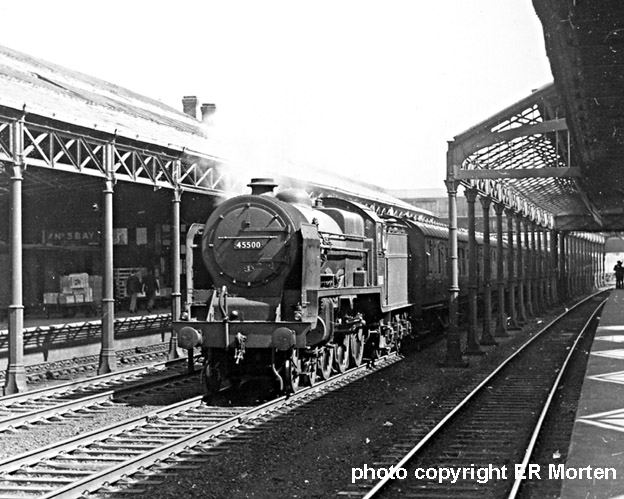

(Above) When HG Ivatt became CME at the LMS, his aim was to improve the performance of existing steam classes and several modifications were made to a batch of Stanier 'Black 5' 4-6-0s, including the replacement of the Walschaerts valve gear with the Caprotti variety. Additionally, several members of the class were fitted with double blast pipes and chimneys, including No 44687, seen here at Stafford on 3rd June 1952. 


(Above-Below) Following the energisation of overhead catenaries on the West Coast Main Line south of Crewe (where the wires had been installed to clear 13ft 1ins loading gauge instead of the normal 13ft 6ins height gauge) diagonal yellow stripes were painted across the cabside of locomotives denoting their prohibition from working in electrified areas. The relaxation in clearance was permitted by the Minister of Transport to avoid the costly programme of rebuilding certain bridges and tunnels. Some of the classes prohibited included: 'Royal Scots'; 'Patriots'; 'Jubilees'; Class 4F, 7Fs and 'Coronation' Pacifics which carried the compulsory cabside stripe. The engines permitted to work in electrifies areas had their smokebox door lamp bracket moved to a lower position to prevent locomen climbing up to chimney height in the vicinity of the 25kV overhead wires. There is still four years to go in these shots of 'Jubilee' class No 45556 Novia Scotia (above) and 45688 Polyphemus (below) before the official ban south of Crewe began on September 1st 1964.
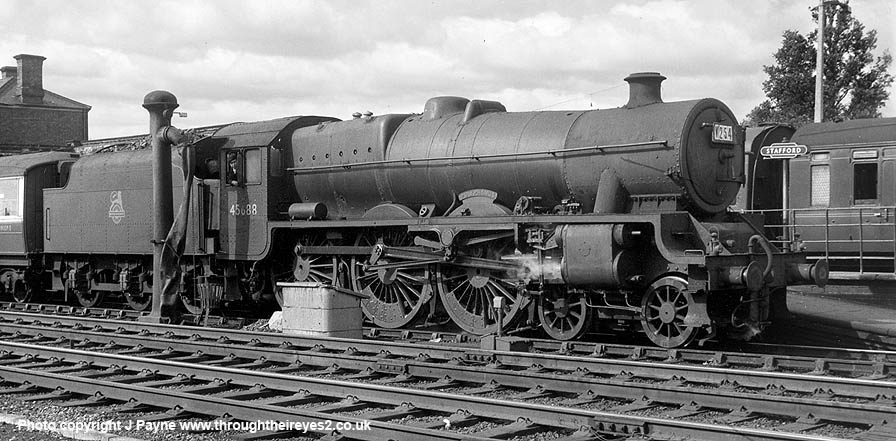
ER MORTEN GALLERY
When Mr Morten's railway photos first appeared on the Internet a lot of people expressed interest in buying his work. All enquiries regarding the purchase of photographs should be made to Jeremy Suter, custodian of his negatives, by email to pa.suter@tiscali.co.uk (In order to avoid spam this is not a 'clickable' mail-to link). Also please note I am not affiliated with the sale of ERM's photos in any way, merely passing on a contact address.





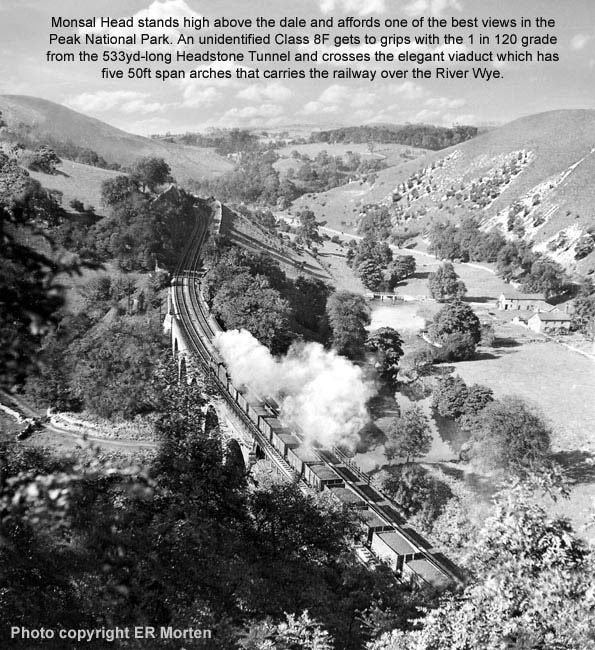


LONDON TERMINI
(Above) Midland Pullman at St Pancras station on 15th June 1962. Initially shown to the general public at Marylebone Station on June 23rd 1960 these trains were a revelation on the railways of the day. There were five trains, comprised of two six-car sets having first class only, which ran the Midland services, and the three eight-car sets, which ran between Paddington and Bristol and also between Paddington and Wolverhampton via Birmingham, which had first and second class accommodation. The Midland Pullman entered service between London St Pancras and Manchester on 4th July 1960 and ceased at the start of electric-hauled trains between Manchester and Euston.
(Below) A pair of unframed carriage prints comprising 'St Pancras Station, London' by Claude Buckle and the 'The Entrance to Euston Station, London' by Claude Buckle, both from the LMR Railway Architecture Series, went under the hammer for £180 at a Great Western Railwayana Auction in April 2015.
(Below) Sporting a 55A (Holbeck) shedplate on the smokebox door, Caprotti 'Black 5' No 44755 rests at the buffer stops at St Pancras on 2nd August 1961.

(Above-Inset-Below) The official photographer captures an interesting display of advertisements near the entrance to the gentlemen's toilets at Euston station in 1944. Although government propaganda posters  were produced in large numbers during World War II, commercial advertising continued unabated; here we see posters for Mackintosh's Quality Street chocolates, Swan Vesta matches, Duraflex shoes, Beecham's Lung Syrup, Dewar's White Label whisky, military uniform tailors and religious tracts. (Inset) An elevated view of Euston's Platform 13 prior to departure of 'The Royal Scot' circa 1933. Introduced in 1862, the Anglo-Scottish express left Euston station daily at 10 am for the 400 mile journey to Glasgow. (Below) 'Royal Scot' class 4-6-0 locomotive No 6139 Welch Regiment makes a spirited start from Euston station in 1928. These photos are released under the Creative Commons Attribution-NonCommercial-ShareAlike licence. In a nutshell, this means they are free for non-commercial use as long as you credit '© National Railway Museum and SSPL' and add a link to the page of origin, in this case, the NRM's Euston Collection HERE.
were produced in large numbers during World War II, commercial advertising continued unabated; here we see posters for Mackintosh's Quality Street chocolates, Swan Vesta matches, Duraflex shoes, Beecham's Lung Syrup, Dewar's White Label whisky, military uniform tailors and religious tracts. (Inset) An elevated view of Euston's Platform 13 prior to departure of 'The Royal Scot' circa 1933. Introduced in 1862, the Anglo-Scottish express left Euston station daily at 10 am for the 400 mile journey to Glasgow. (Below) 'Royal Scot' class 4-6-0 locomotive No 6139 Welch Regiment makes a spirited start from Euston station in 1928. These photos are released under the Creative Commons Attribution-NonCommercial-ShareAlike licence. In a nutshell, this means they are free for non-commercial use as long as you credit '© National Railway Museum and SSPL' and add a link to the page of origin, in this case, the NRM's Euston Collection HERE. 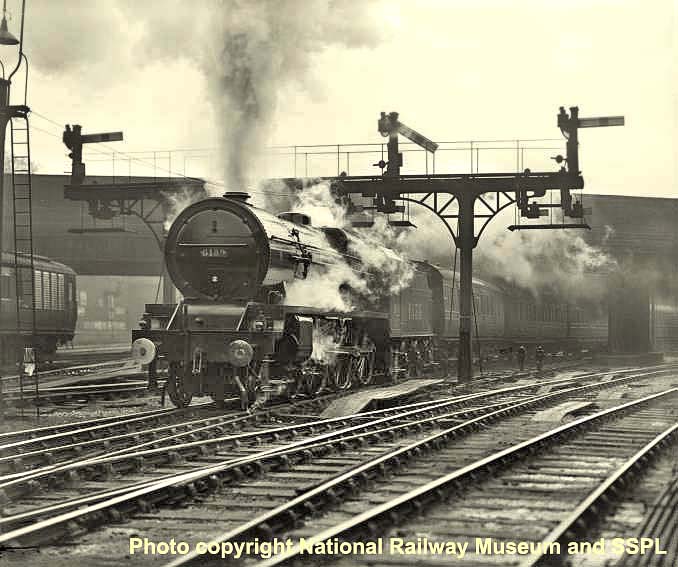

To be continued...
Polite notice: All text and photographs are protected by copyright and reproduction is prohibited without the prior consent of the © owners. If you wish to discuss using the contents of this page the email address is below. Please note - this is not a 'clickable' mail-to link via Outlook Express. You will have to email manually.
dheycollection@ntlworld.com




